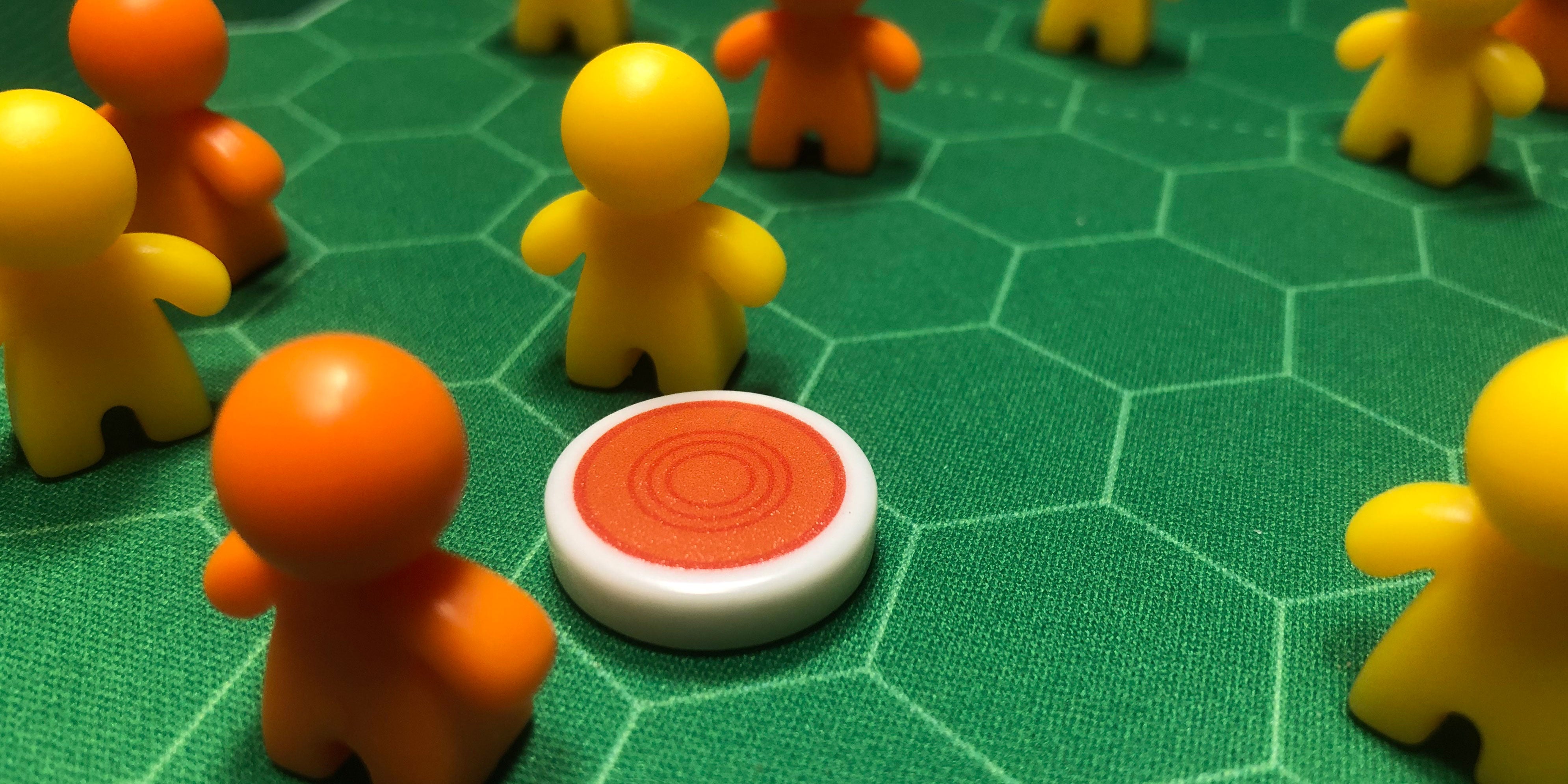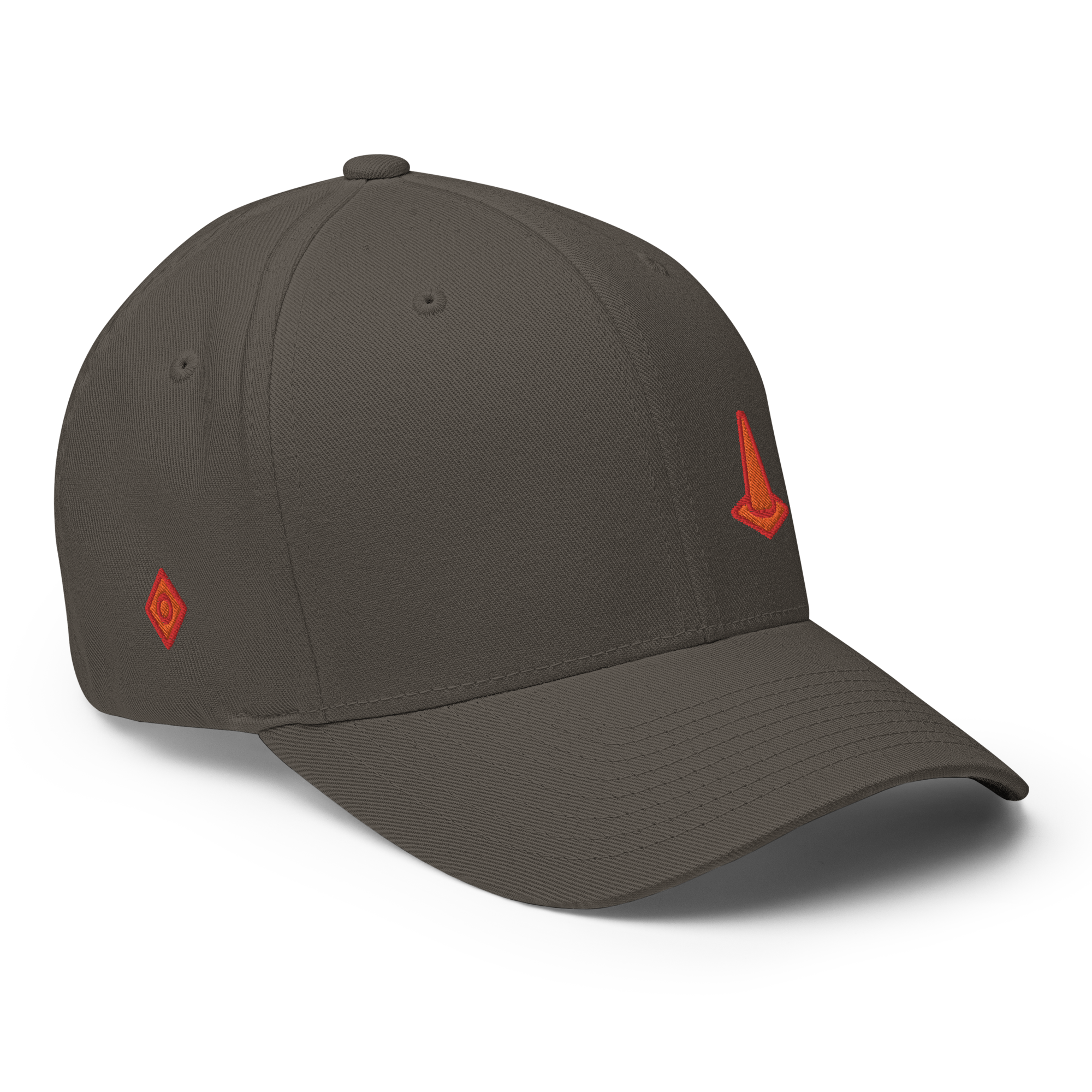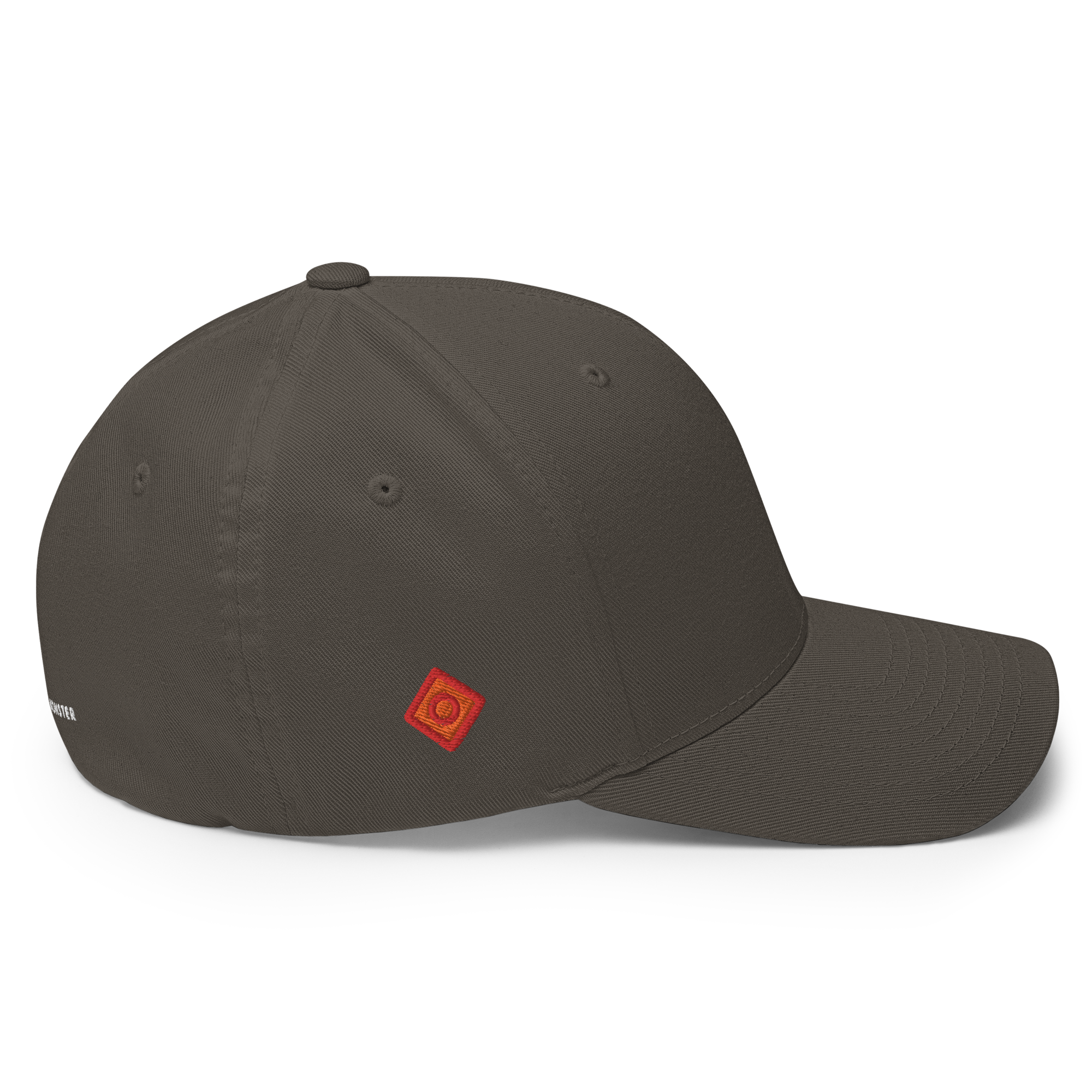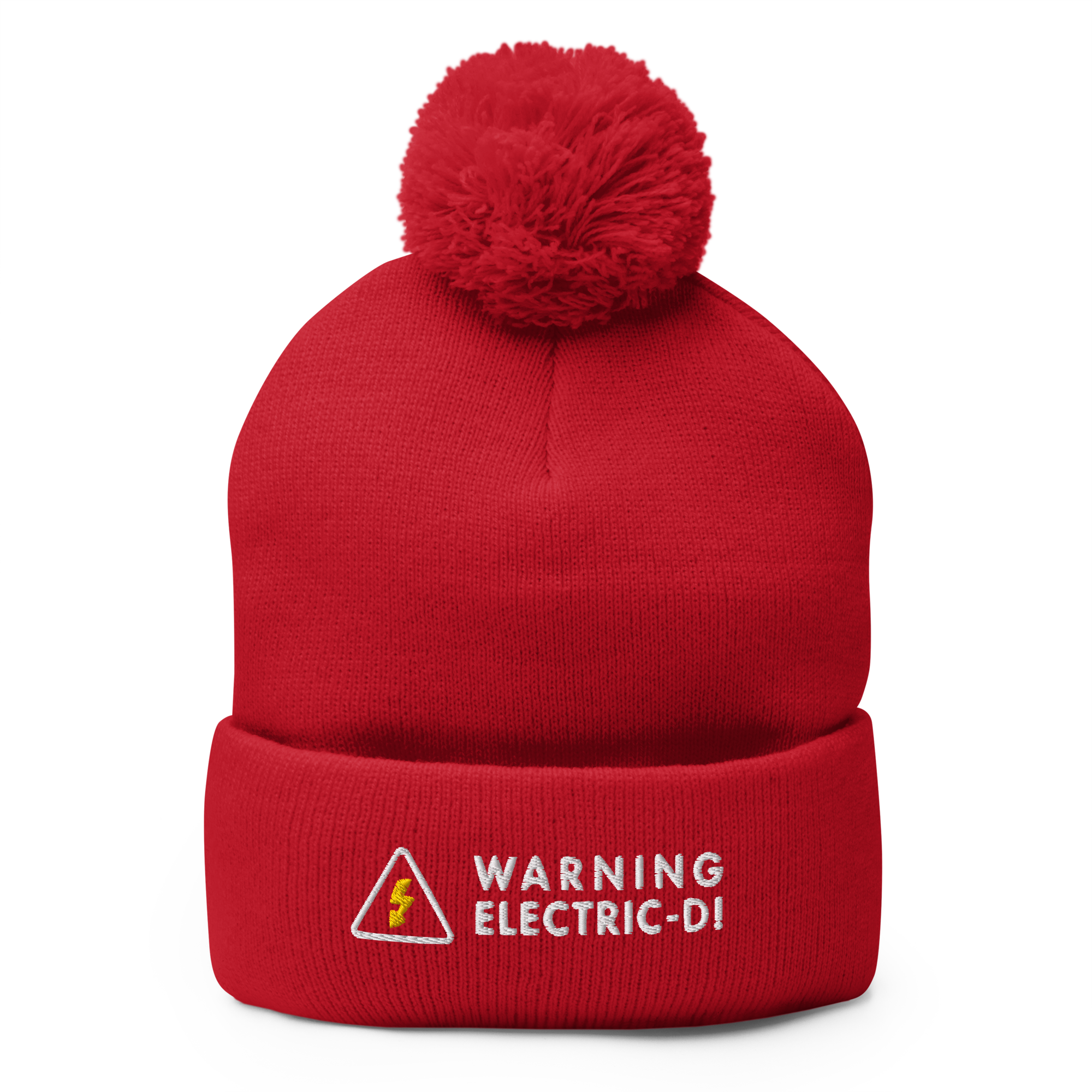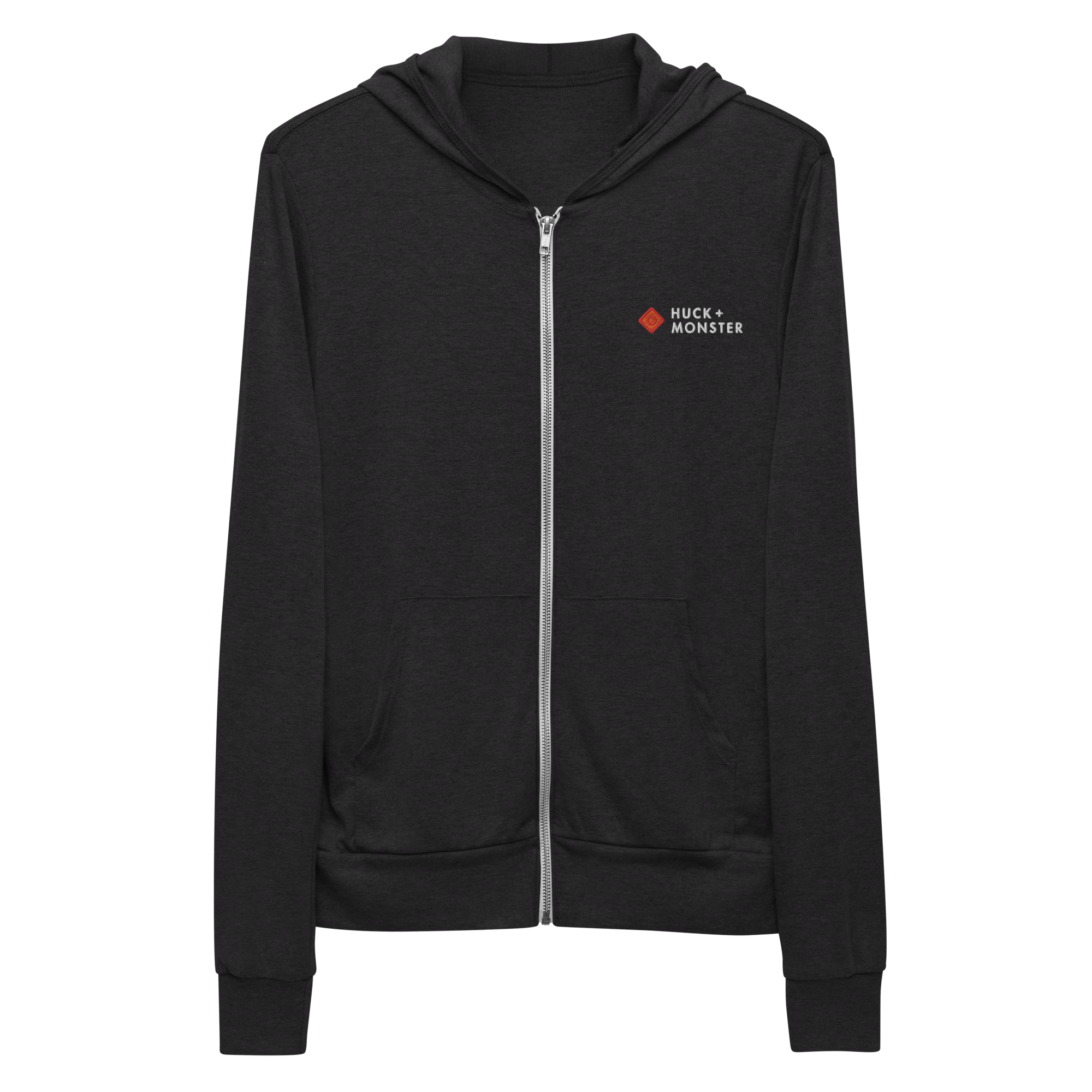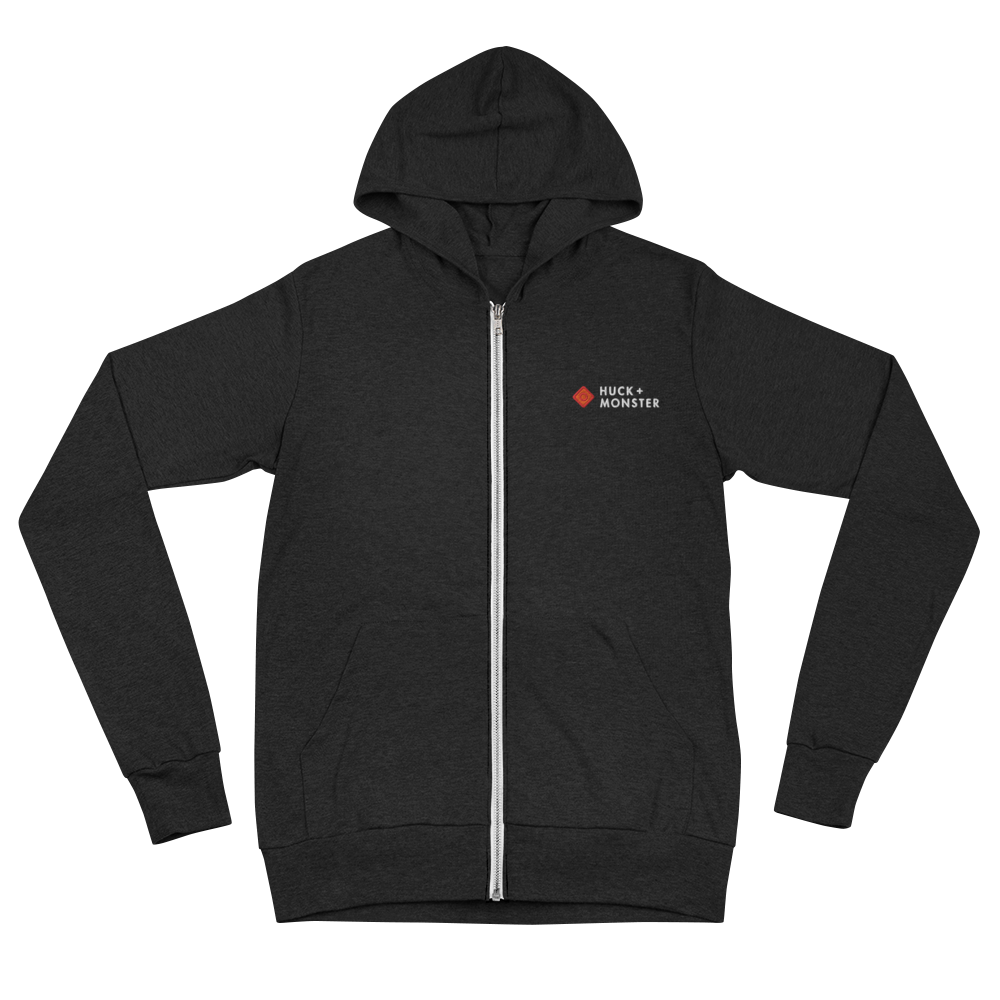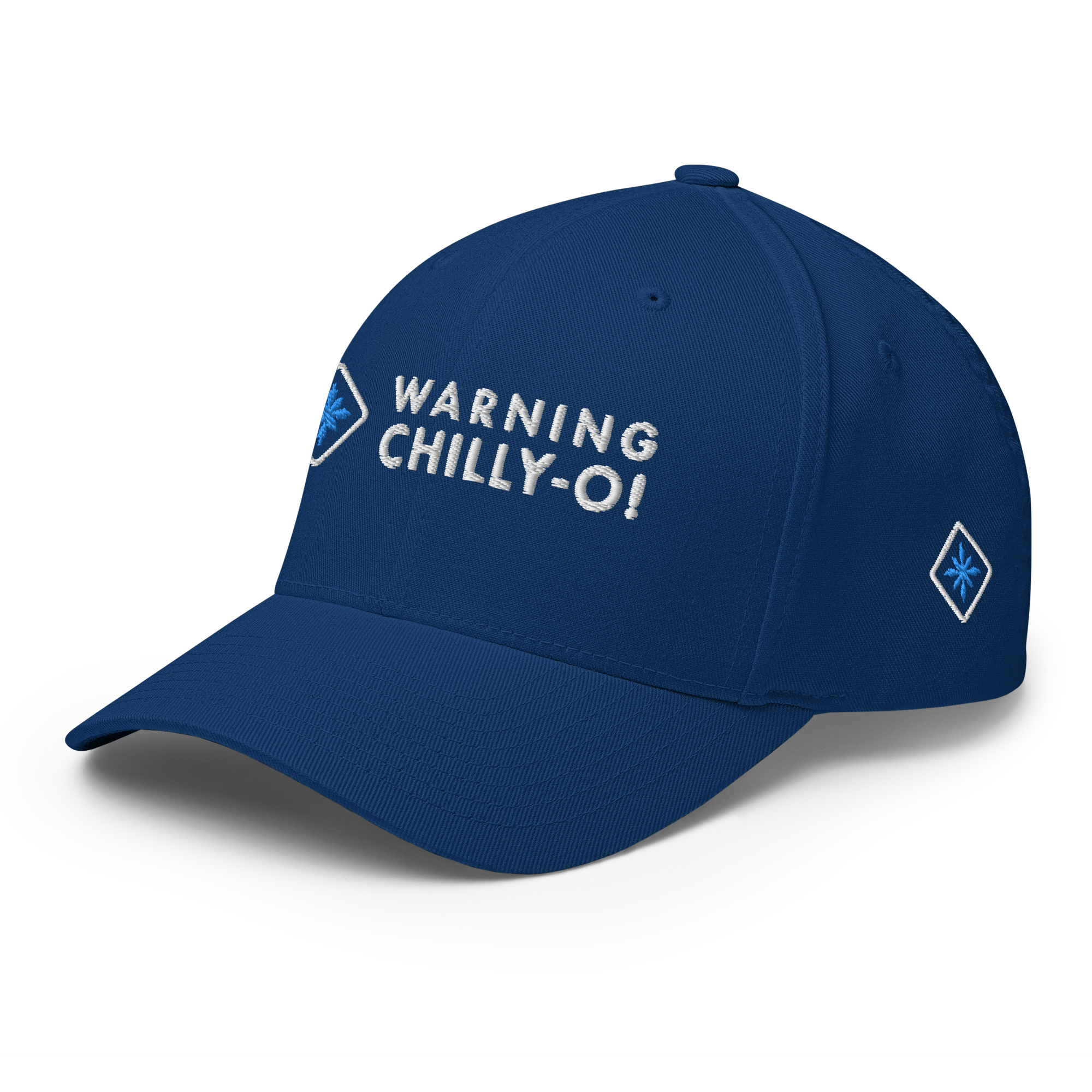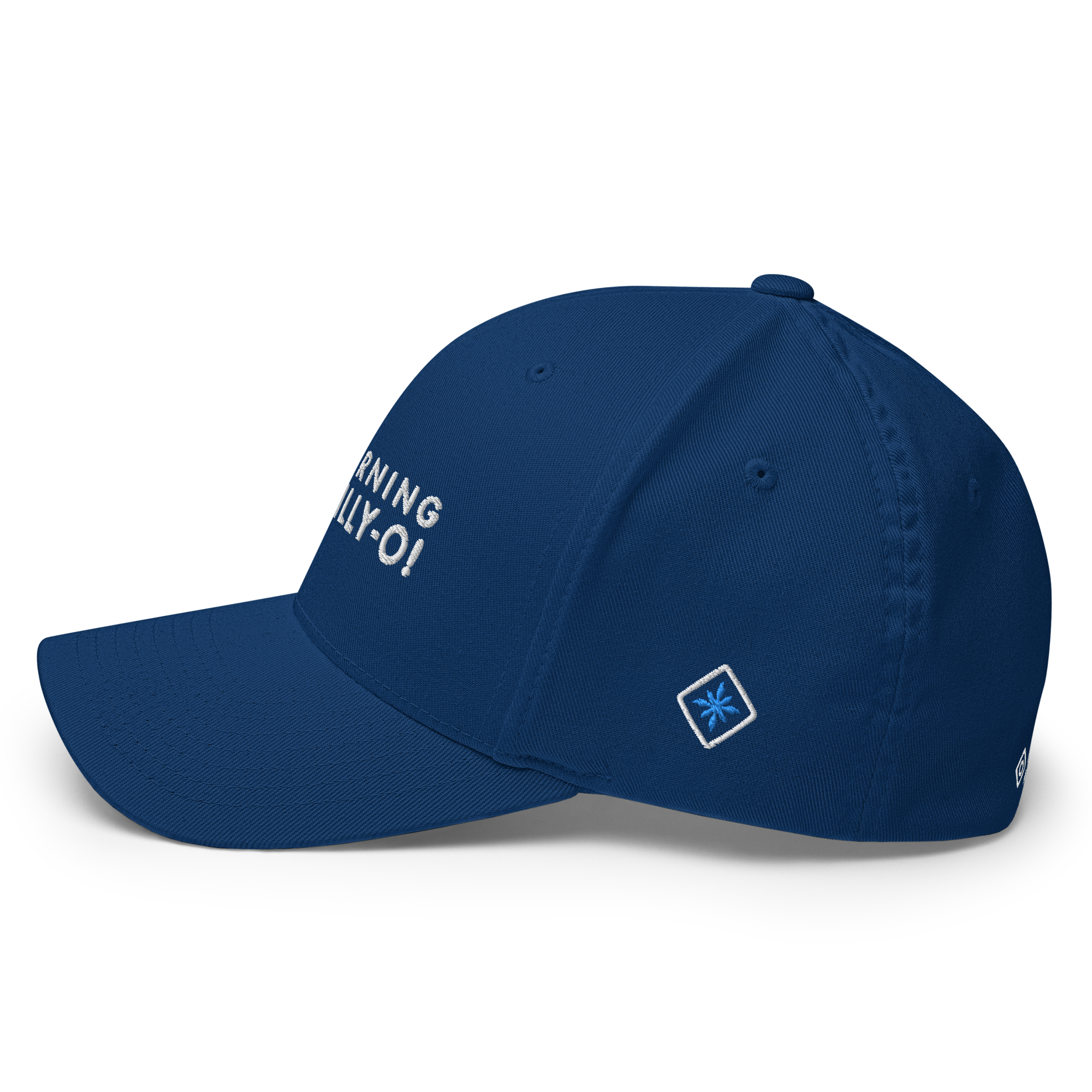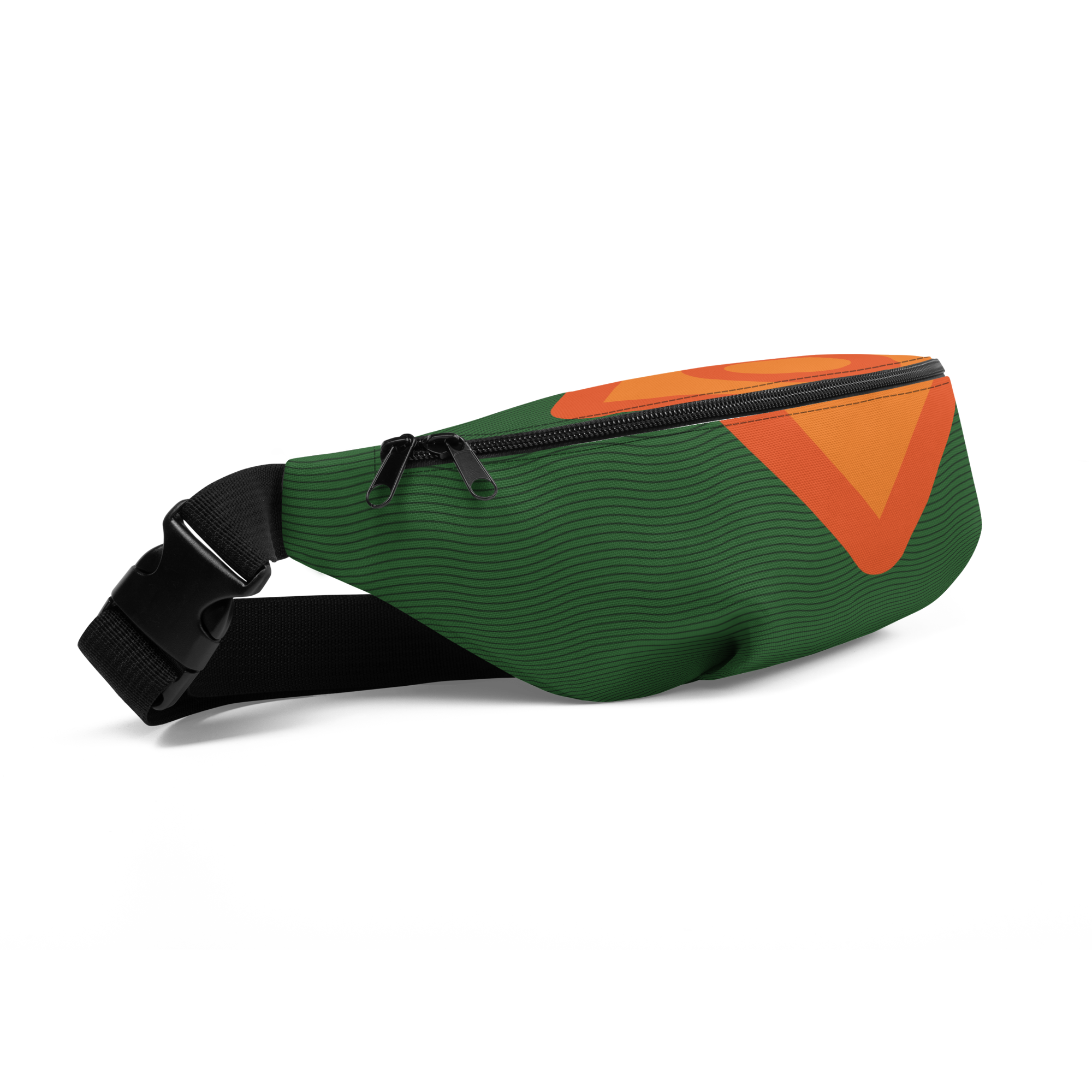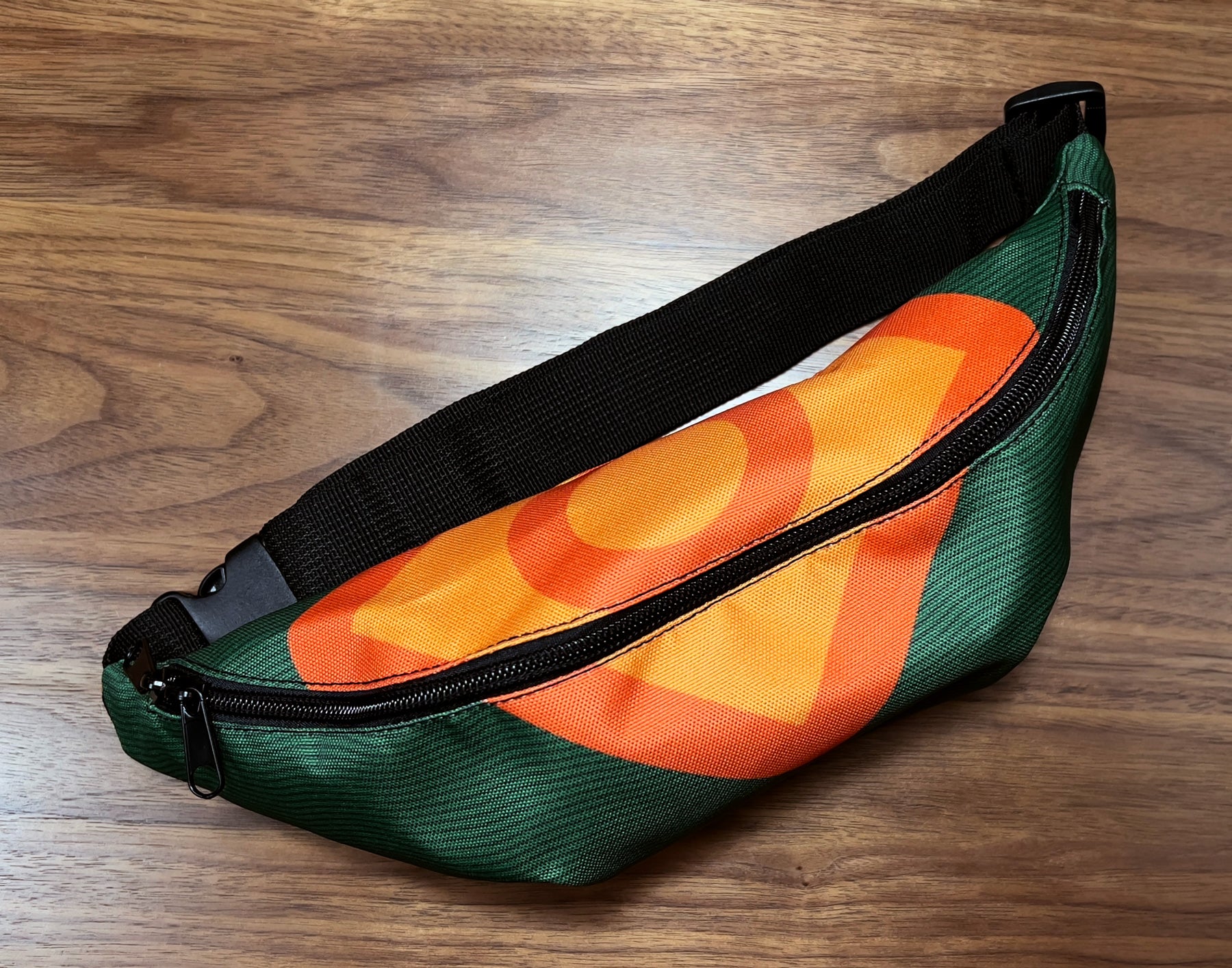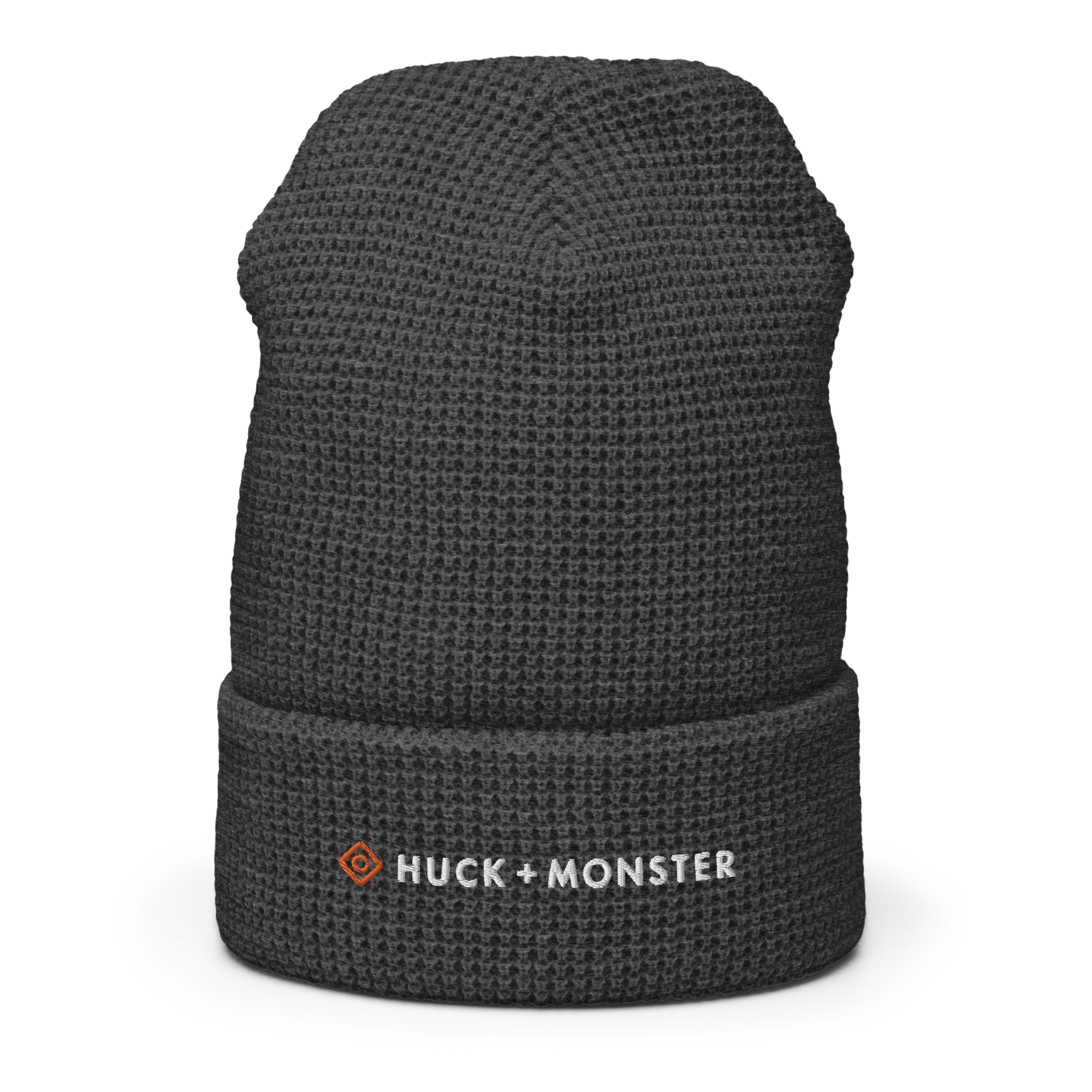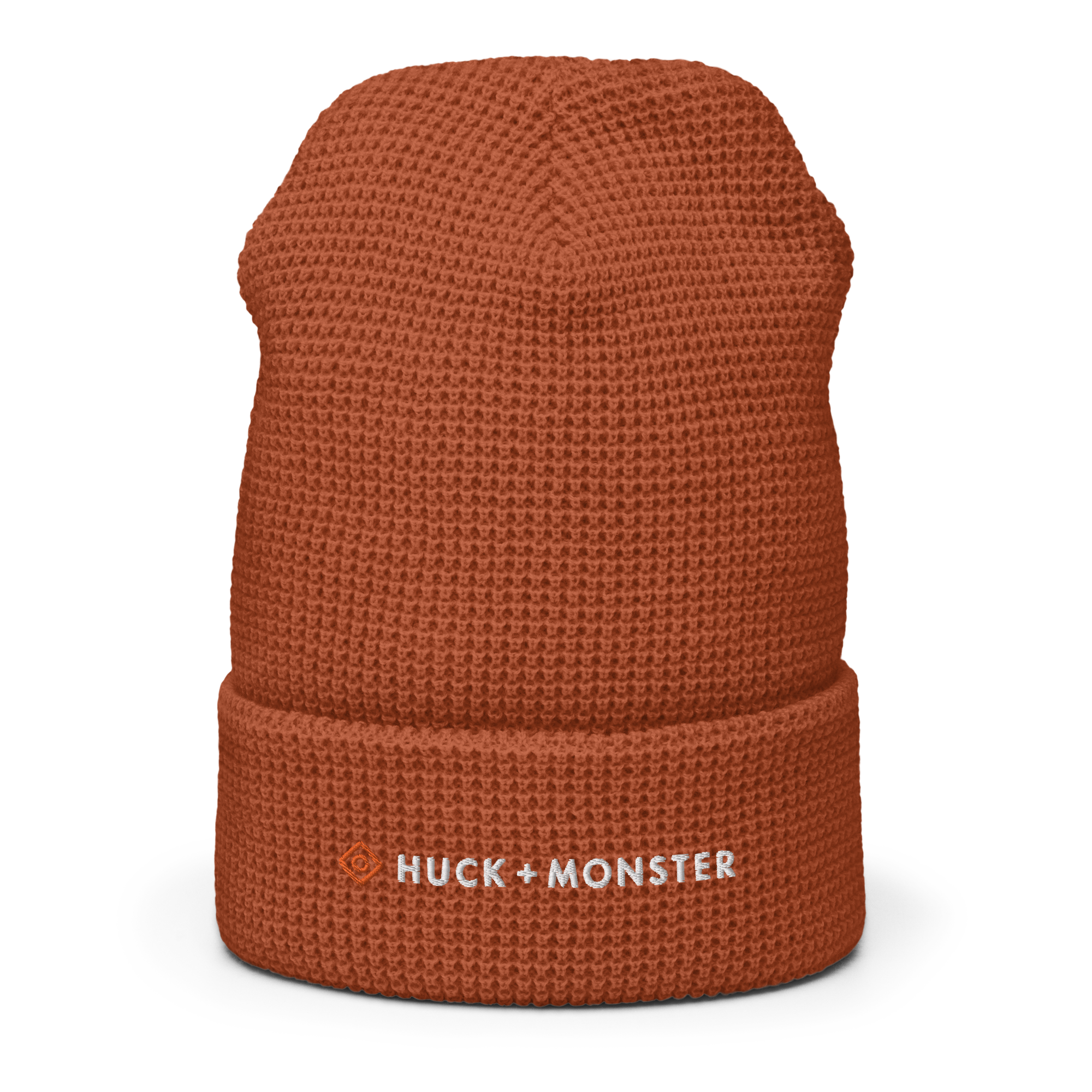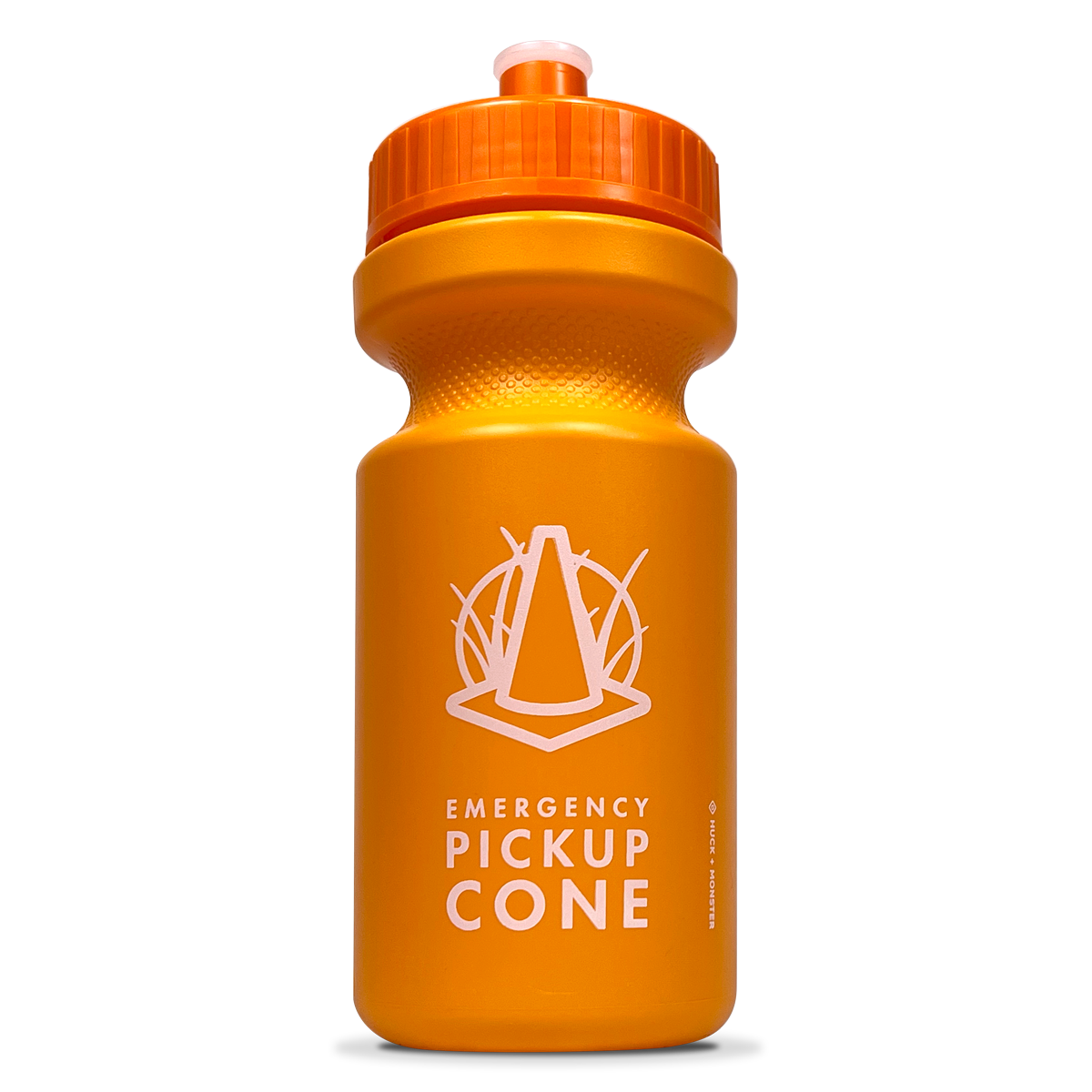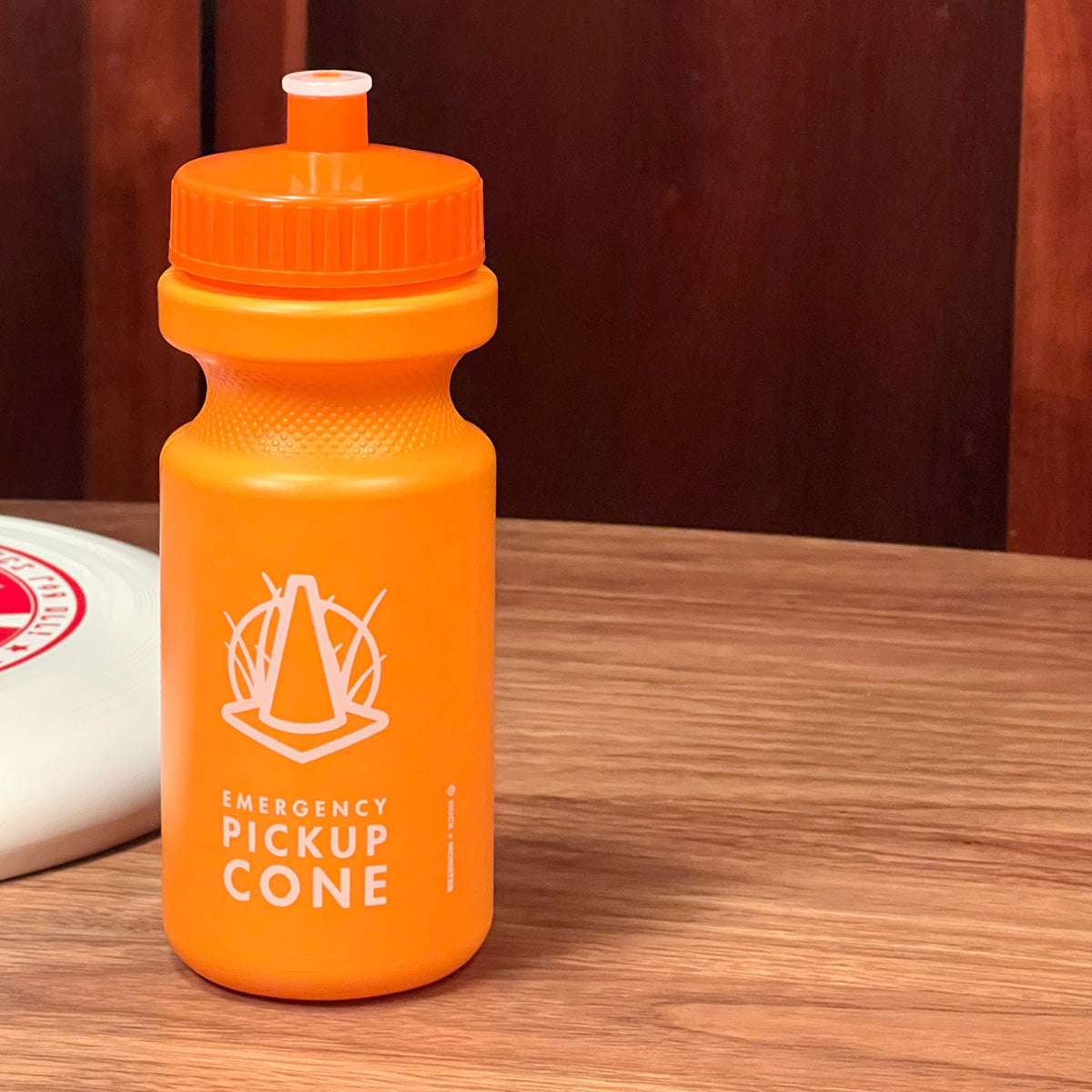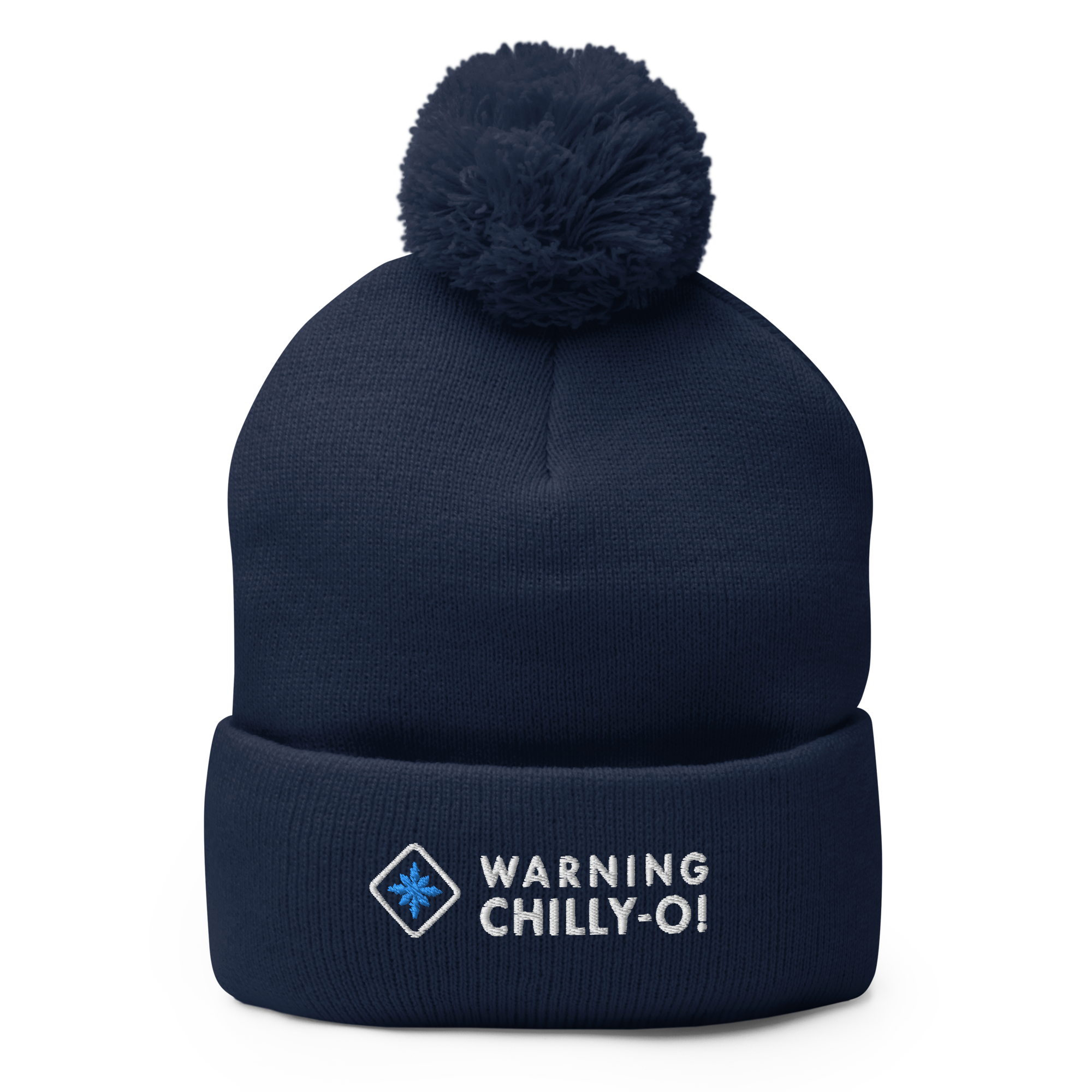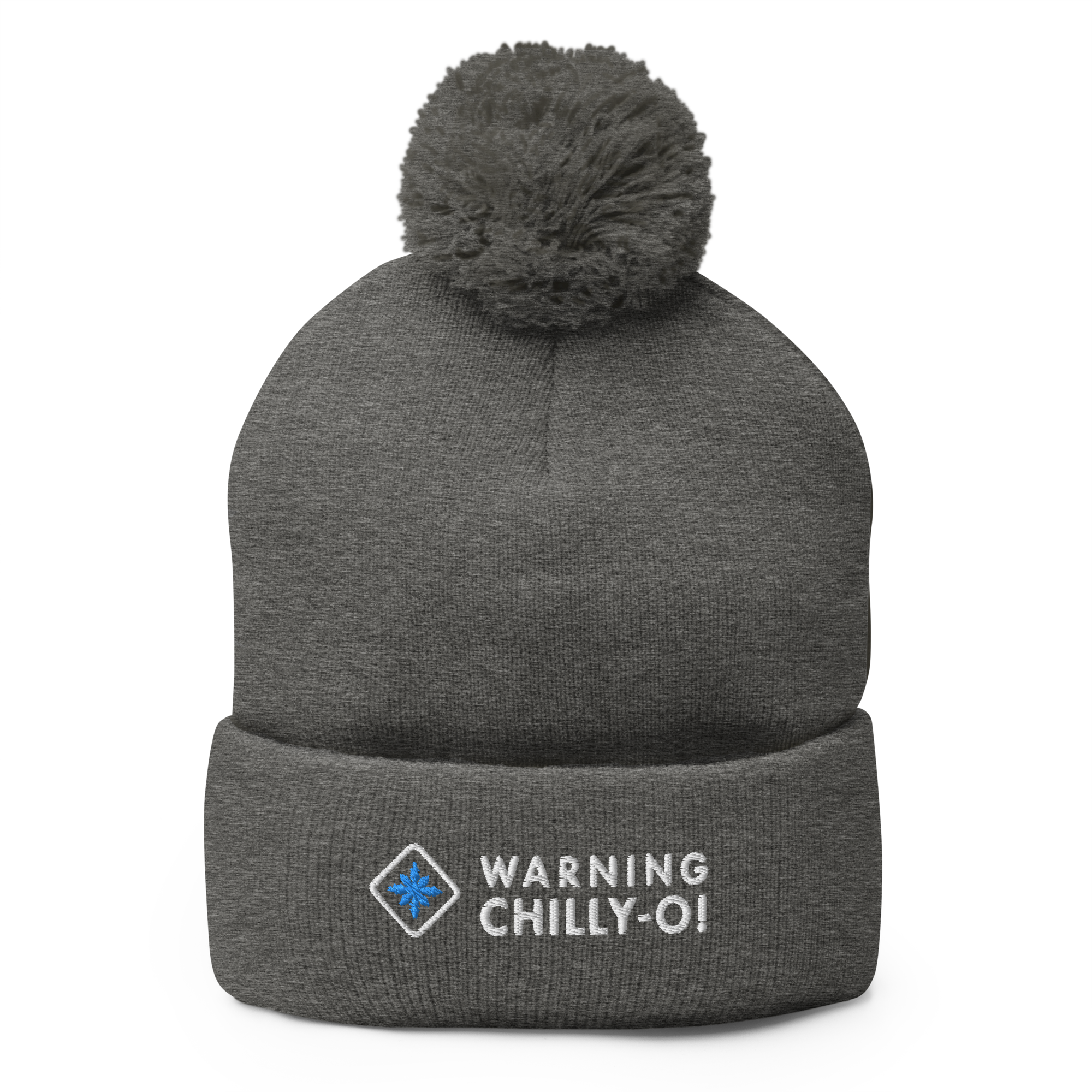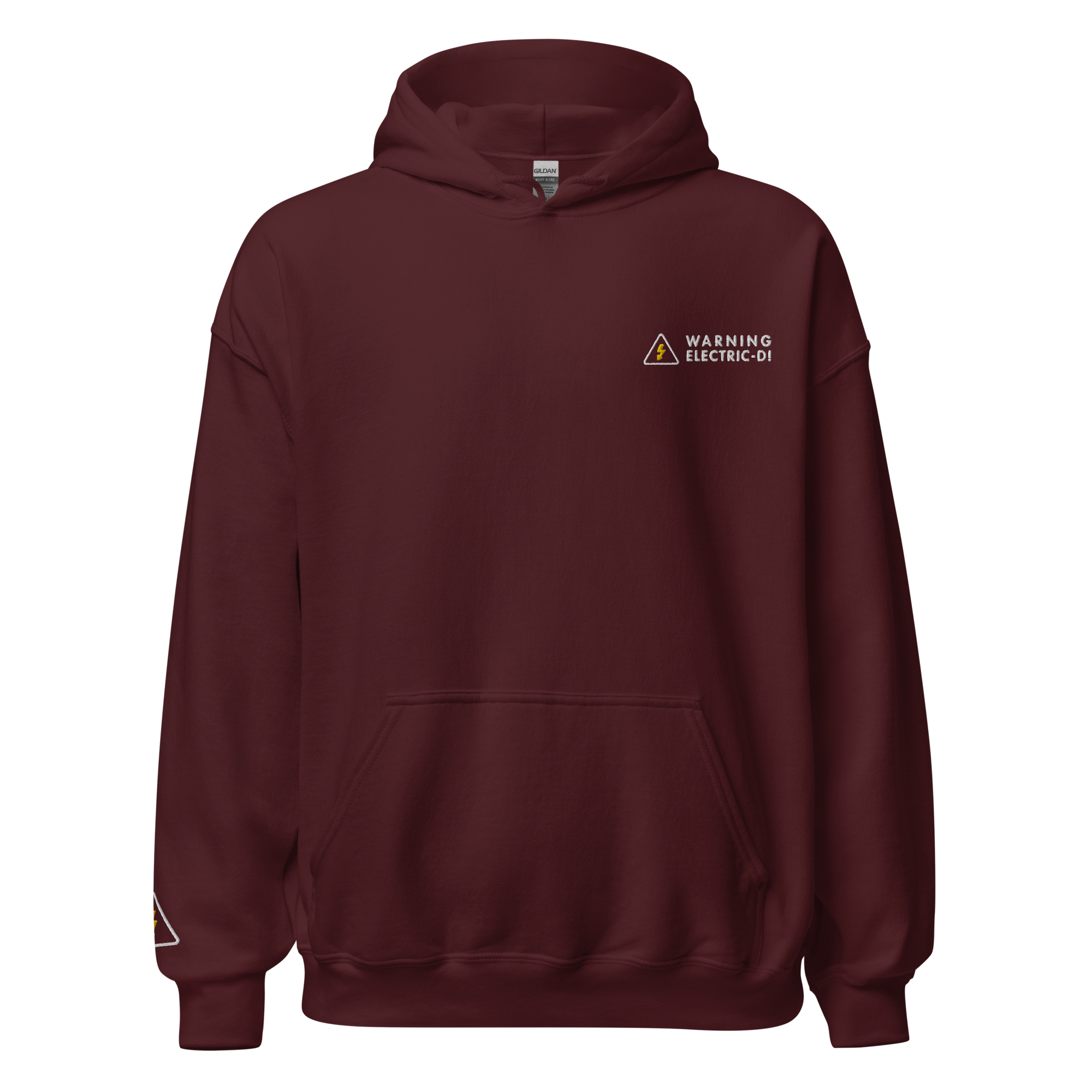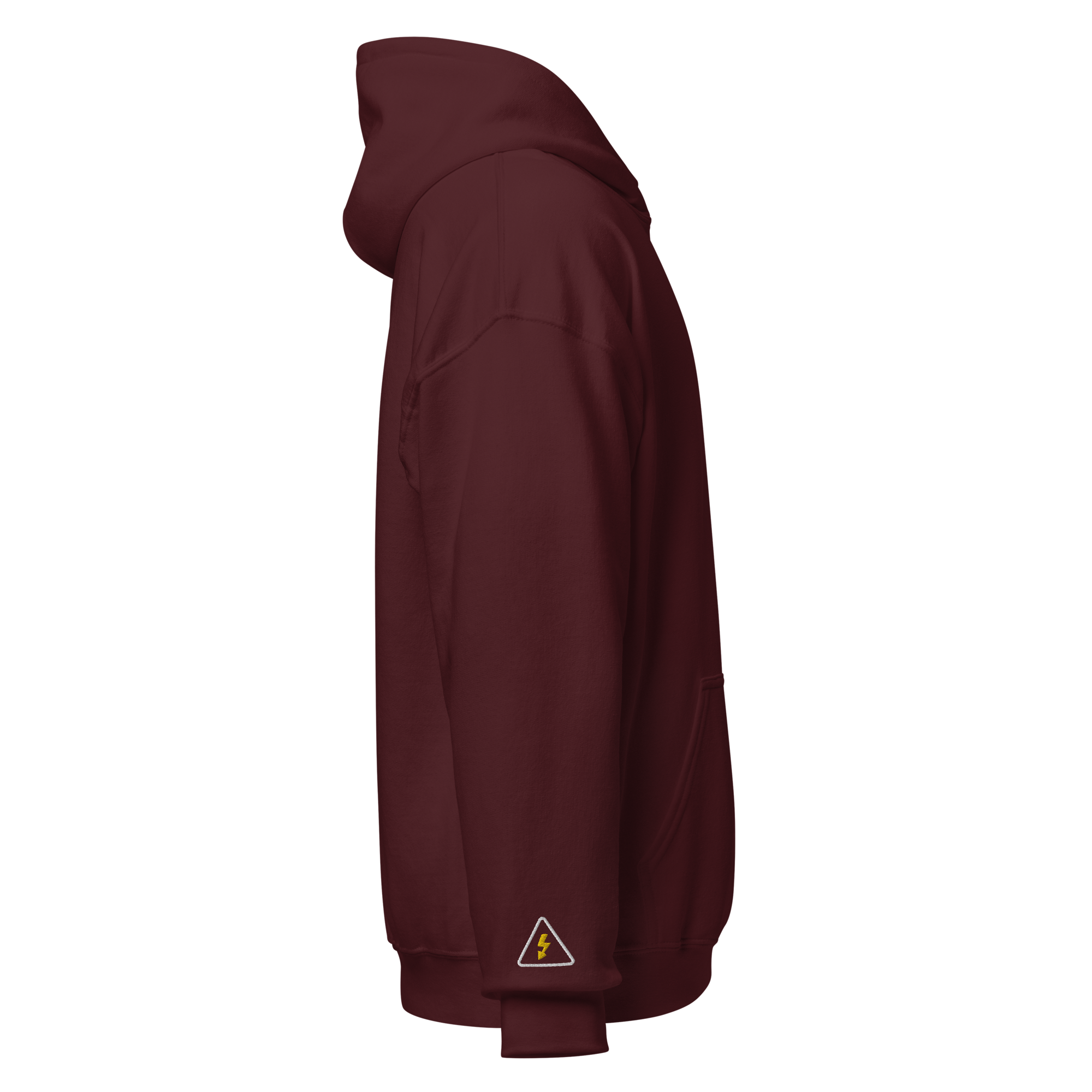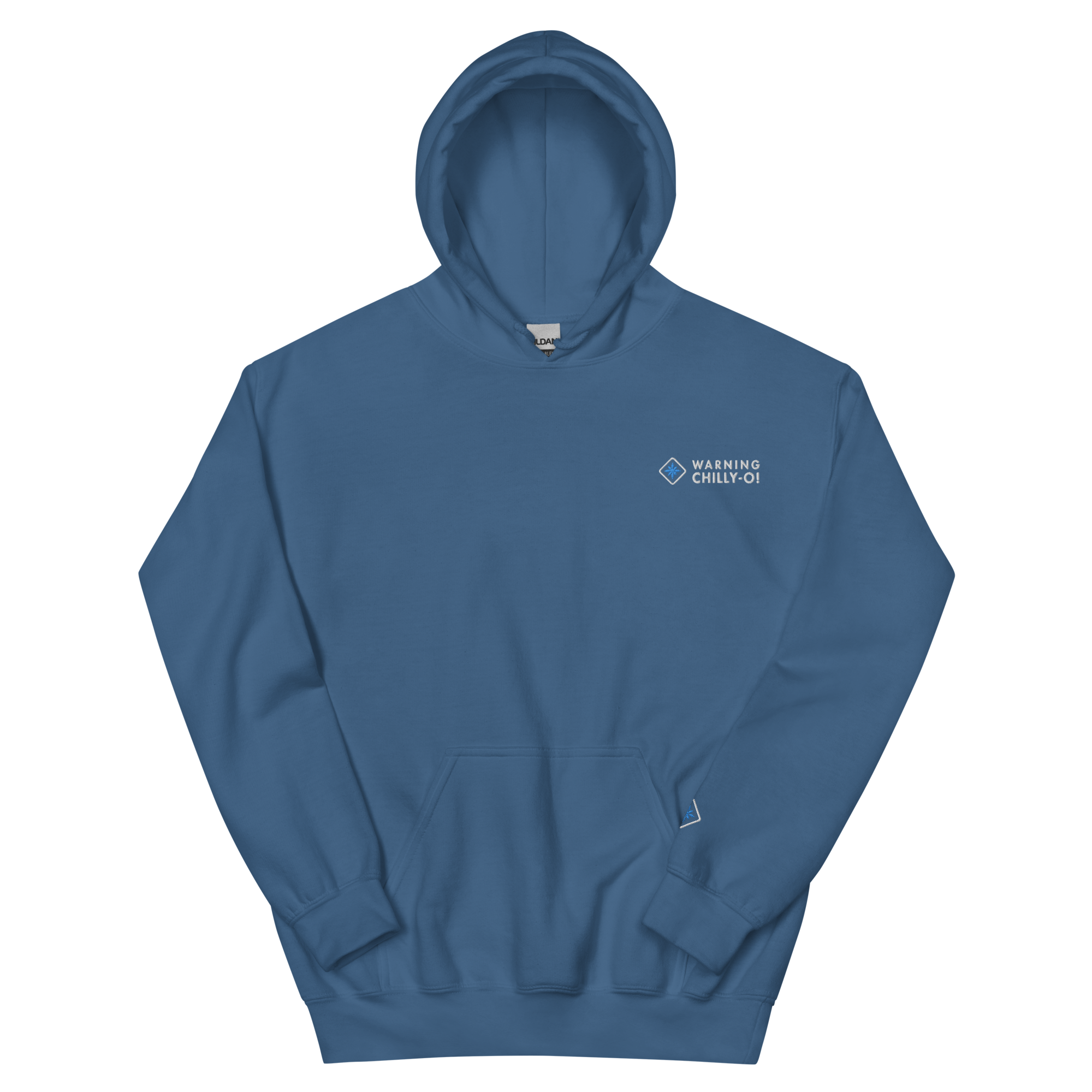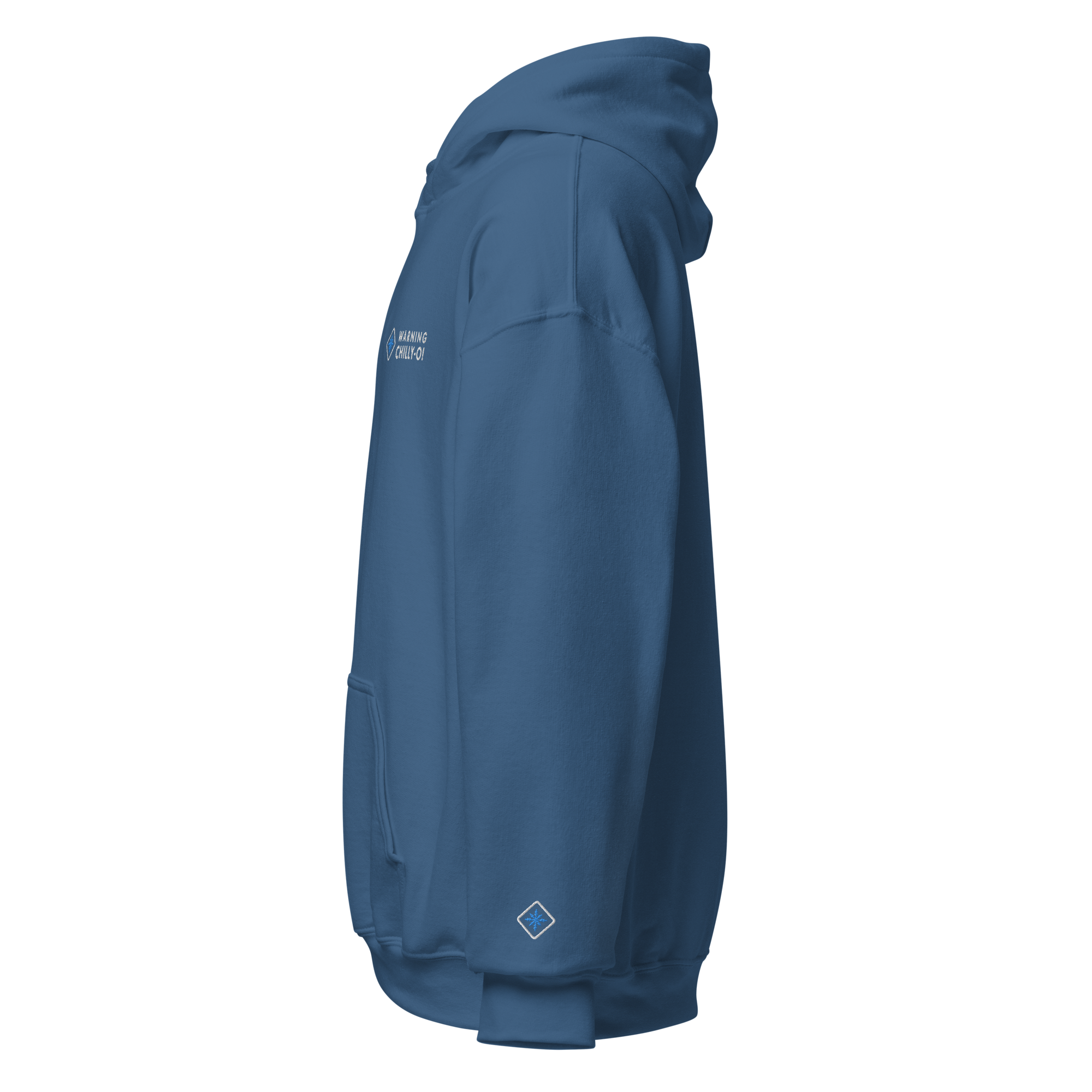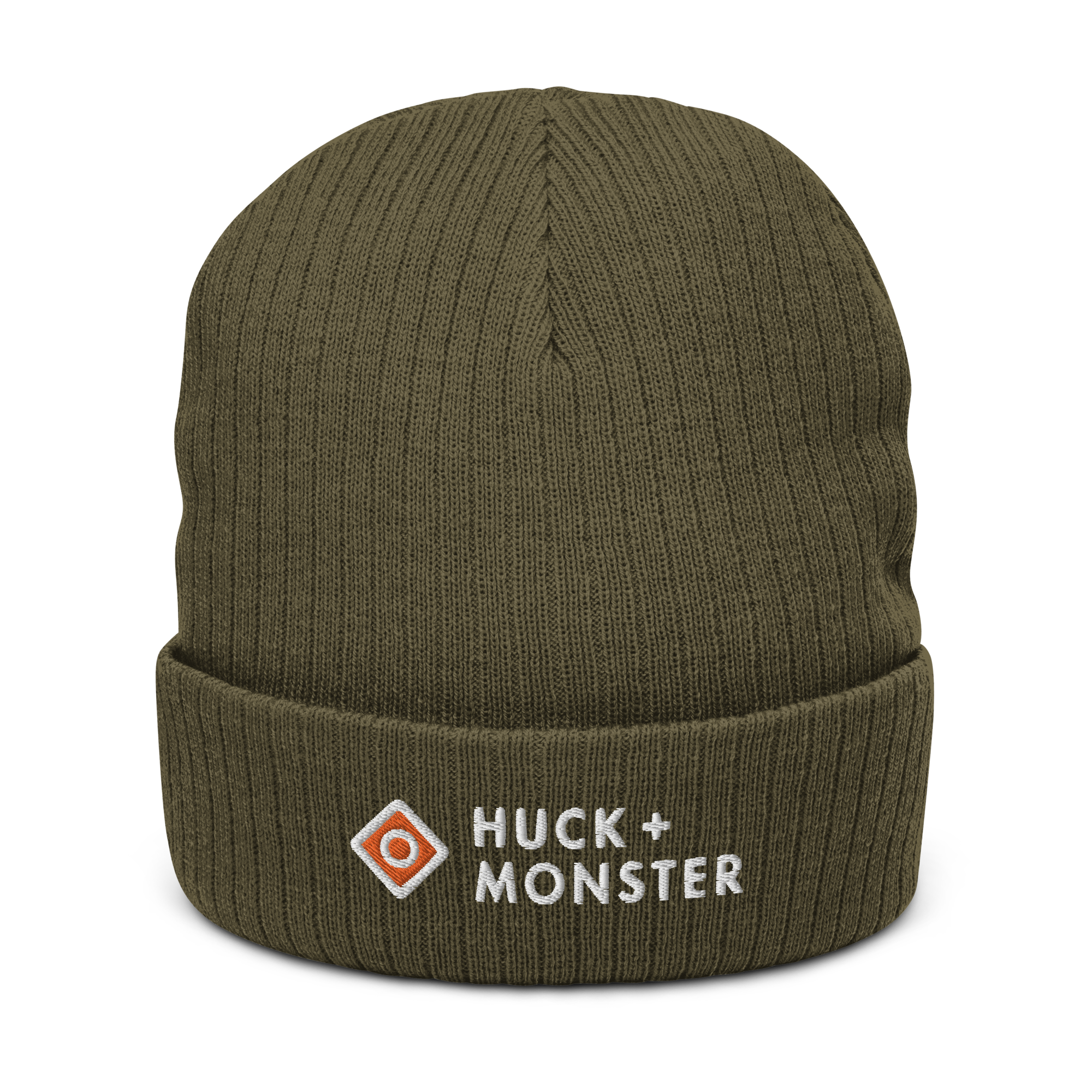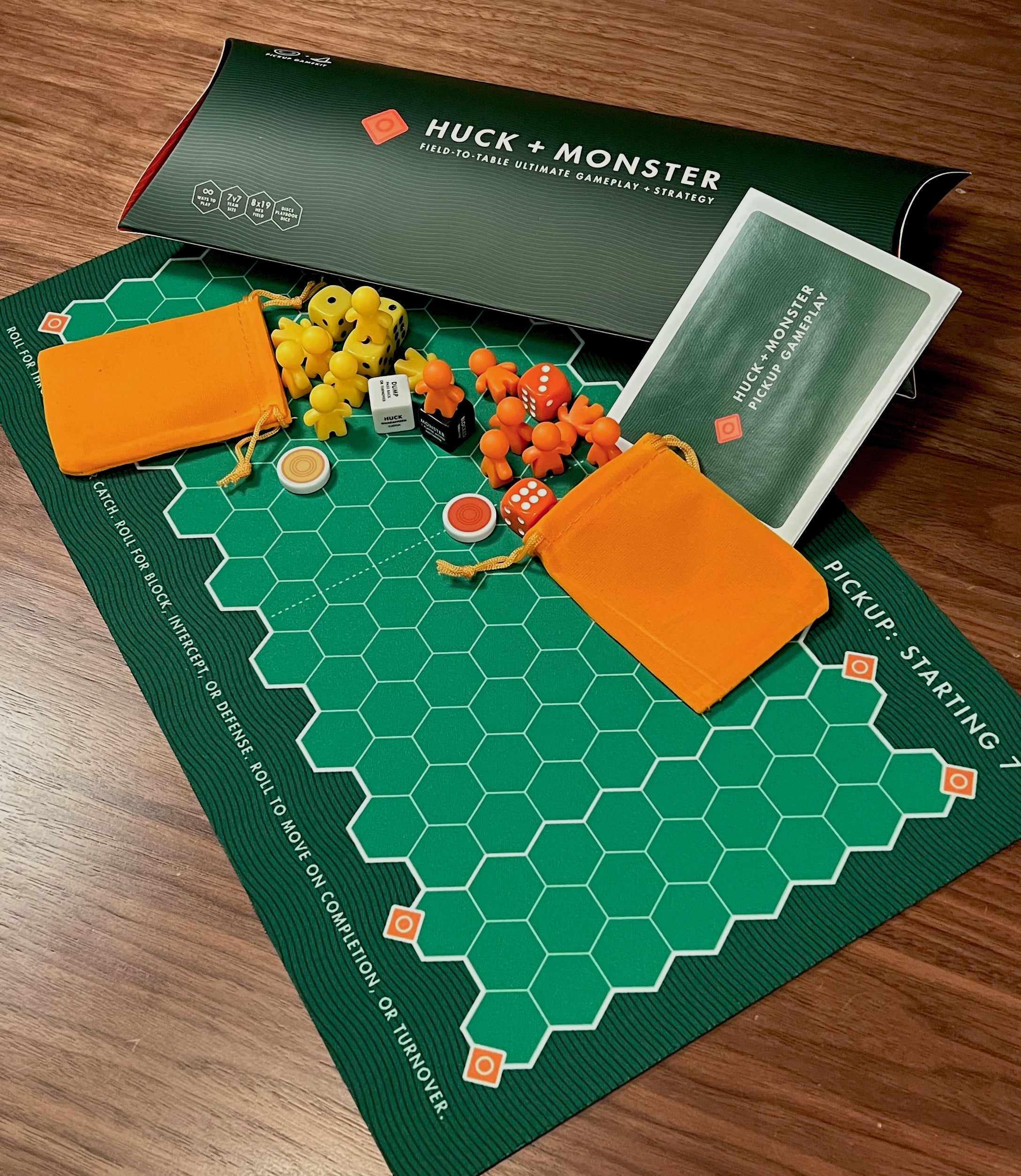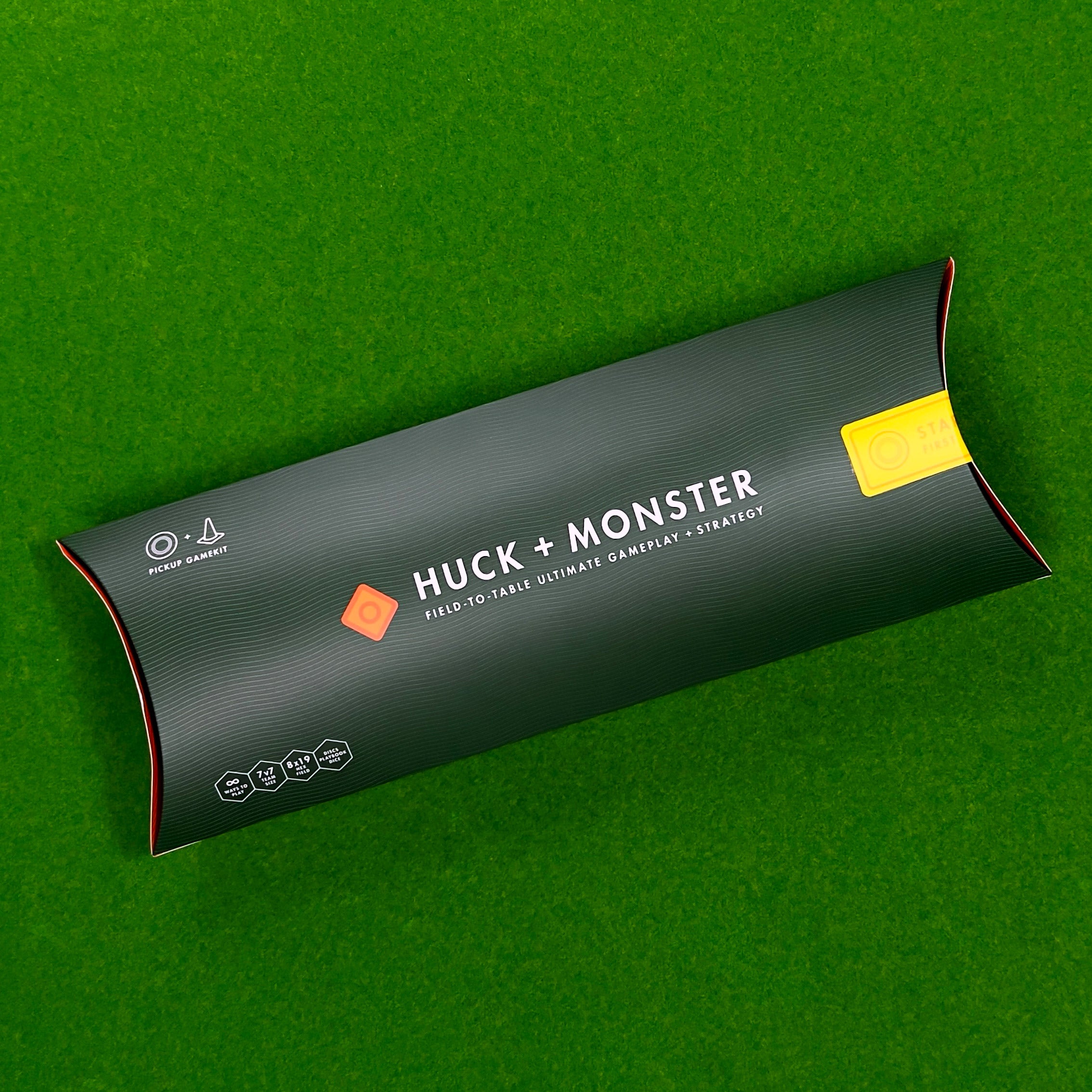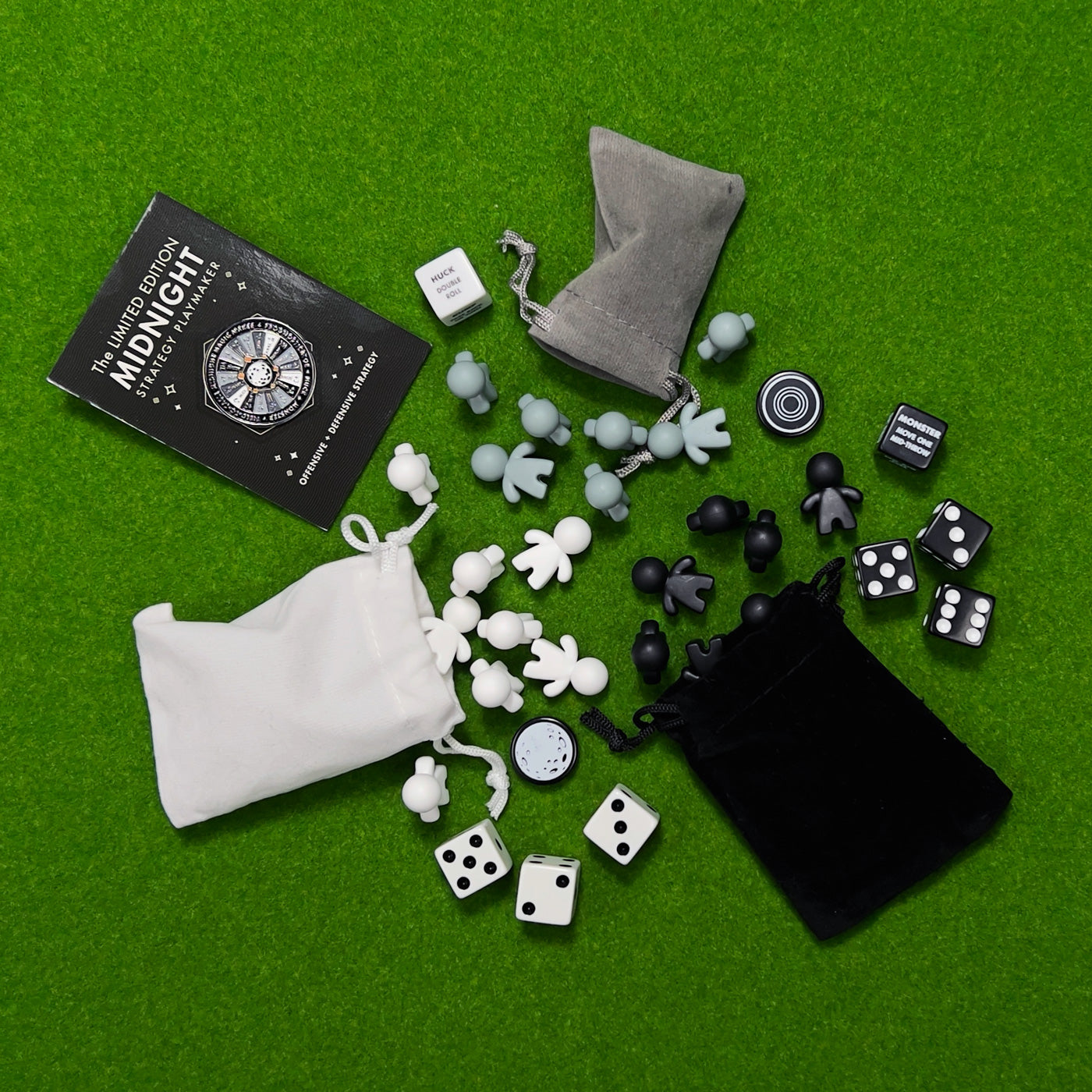The OFFICIAL GAME RULES
This regulation game guide is formatted in a "classic board game" style, which includes the extensive full ruleset for all Huck + Monster game variations. Starting Coaches, please refer to the Quick Guide. Returning Coaches, please refer to the Visual Guide.
The REGULATION GAME GUIDE
End-to-End Gameplay
Ultimate Tabletop Gameplay + Strategy
Huck + Monster is a field-to-table Ultimate game that condenses the action and strategy of on-field Ultimate play into a travel sized, sideline ready, turn-based gamekit.
Coach your Ultimate Team by strategically positioning your players to open up optimal offensive throw paths and cutting lanes, or by creating defensive Ultimate plays, using coordinated defender actions.
Score 1 point for every successful catch in your opponent's end zone. Score 3 points to win a short game (Scrimmage), or 7 points to win a regulation game (Pickup).
The Basics
• Two Ultimate teams bid for control of the game disc, in a strategic race to complete end zone catches to score points. Position seven Ultimate team players strategically on the game field to move the game disc toward the opponent's end zone.
• Use player position to gain an advantage over the opposition during each team move. Use offensive player advantages to move the disc from player positions, while avoiding well-placed Ultimate defenders. Use defensive player advantages to defend the end zone through player matchups, disc bids, and defensive actions.
• Move your team after successful Catches, Turnovers, or Pulls. Position your offensive team to successfully pass the game disc from player to player. Position your defensive team to prevent disc movement, while also placing key defenders to quickly score after successful turnovers.
• Like the game of Ultimate, disc possession is dynamic. Offensive players control the game disc during Up Calls. Defensive players matchup against offensive players to bid on the game disc. Successful defensive actions result in a turnover. Successful defenders become the Handler during the next Up Call.
• Complete successful catches in the opponent's end zone to score. Score 7 points to win a full "Pickup Game". Score 3 points to win a "Quick Scrimmage". Track wins to determine sideline tournament Champions on your real-life Ultimate team.
Starter Game Equipment
• 1 Pickup Game Field
• 2 Teams + Equipment Sets
• 16 Total Players (2 Backup)
• 6 Color Coded Team Dice (D6)
• 2 Color Coded Game Discs
• 2 Strategy Dice
• 2 Velvet Team Bags
• 1 Pickup Instruction Guide
• 1 Gameplay Field Manual
• 1 Cardboard Game Package
Field Setup: Huck + Monster
Unroll the Huck + Monster game field, and place the game mat neoprene side down, fabric side up, on any semi-flat surface.
Summary: "Huck" is offense. "Monster" is defense.
Each Coach selects a team bag, which includes Ultimate players, game equipment, and strategy dice.
• Team bag includes 8 color coded team players, which match the color of the team bag. Set 1 player aside to act as a backup player if one of the 7 on-field players gets injured (or lost).
• Team bag includes 3 standard D6 "Team dice", which match the color of the team bag. Team dice are used for all player actions or team moves. Team dice are added together in different combinations throughout the game to get different "Counts", or "Bids".
• Team bag includes 1 custom "Game Disc", printed in two sides. The first side of the game disc matches the team color. The opposite side of the game disc is either white, or the color of the opposing team. Flip the game disc during Turnovers to indicate which team has possession of the game disc.
• Team bag includes 1 custom D6 "Strategy dice", printed with different Ultimate actions for gameplay. The dice marked "Huck" is used by the acting offensive team. The dice marked "Monster" is used by the acting defensive team.
• The team bag that includes the strategy dice labeled "Huck" starts the game as offense, receiving the starting throw. The team bag that includes the strategy dice labeled "Monster" starts the game as defense, initiating the starting throw.
Playmaker Pins
Limited Edition Gamekits that include Playmaker Pins require additional consideration upon setup.
Attach any available Playmaker Pins directly to the neoprene game mat, as indicated at the center/top of Limited Edition game fields.
Team Pins should be pinned on either side of the central Strategy Playmaker pin. When using Team Pins, switch end zones as needed after points by rotating the game field 180 degrees, effectively "flipping" the end zones, and the corresponding Team Pin "polarity".
View the Expansions section below for additional information regarding Playmaker Pins.
Handler Tip: It is easiest to keep track of game play if the end zone you are defending is directly in front of you, and you are facing the opposing team across the full Huck + Monster game field.
Team Setup: Overview
The offensive team controls the game momentum by moving the game disc toward the opponent's end zone. The defensive team positions players to prevent the disc from moving toward the defensive end zone. Player matchups occur when more than one player is in a position to act on the game disc.
Offensive Team
Position offensive players to keep multiple passing lanes open for Throws, Continues, and Catches.
Keep passing lanes open by positioning your players on the field in such a way as to maximize the strategic advantage of Dump passes, hard strikes, or break-force plays which could provide opportunities to move the game disc around potential defenders.
Defensive Team
Use on-field Ultimate tactics to position defensive players into a Zone, Hex, or Swarm formation to stop the the offensive push toward the defensive end zone and create turnover opportunities.
Maximize the effectiveness of defensive Marks, Intercepts, and Challenges, while also planning for the next turnover. Position defenders to become the next well-placed Receiver after critical turnovers to quickly change the momentum of the game.
Matchups
When an offensive and a defensive player are both positioned to take action on the game disc, the eligible players will "Matchup" using competing player actions to determine bid success.
By positioning players strategically, the offensive team can effectively minimize the number of defensive bids against offensive actions, increasing the chances that a Catch can be successfully completed.
Based on the statistics involved, most bids will be won by the Offensive team. However, based on the player positions involved, the defensive team can easily shift the initial offensive mathematical advantage in favor of the defense.
Team Setup: The Line
Add 7 players to the inside of each end zone line. End zones are limited to the 3 rows of spaces on either end of the Pickup field, as indicated by a solid white line (commonly referred to as "The Line").
Summary: Add 7 Players to each line to begin every new game, or after a point is scored.
{Huck + Monster team bags come with an extra 8th player. Place the extra player on the sideline to heckle gameplay. Call them in if other players don't show up for practice.}
Place the offensive game disc on any open defensive line space inside the end zone. Ensure that the game disc color matches the offensive team color, not the defensive team color, before rolling to Throw.
Minimize the distance between your starting players and the resulting initial throw position by placing your team inside the end zone, on any open space closest to the line.
When both teams are ready, the defensive team (with the game disc) rolls 3 dice to throw the disc to the opposing team to start the point. This starting defensive action is called the Pull.
Handler Tip: When placing the starting game disc on the line: consider the placement of players you will move during your first move, second move, and third move. Oftentimes, where the disc is placed on the line to start the point could limit the second, or third move defensive advantages.
Starting Throw: The Pull
The defensive team begins each game by rolling 3 dice to determine the distance the disc should move on the starting throw. Throws from the defensive line to start the game, or throws to start new points, are called the "Pull".
Summary: The defensive team rolls 3 dice to Pull.
During the pull, the defensive coach moves the offensive game disc toward the offensive end zone.
The defensive team initiates the Pull by rolling 3 team dice to Throw the game disc. Combine the 3 individual dice results to determine the total Throw "count". Counting down from the total Throw count, move the game disc one space at a time until the total count has been completed.
Begin counting on the next open space from any player or disc. Do not include the starting resting space in any move, or action count.
Disc must travel the full distance of the Throw count on the Pull. The game disc is not required to reach the offensive team during the Pull, and should remain on the last space of the count until retrieved by the offensive team; after rolling for team moves.
Over the (offensive) line:
If the total throw count permits, the game disc may travel on any open space, passing "through" the offensive player line, into the offensive end zone. Offensive team does not roll to Continue, or Catch, moving game discs on the Pull.
Offense plays the disc where is lands, even if inside of their end zone. Offensive team moves first upon completion of the Pull.
Ultimate Players: Receiving teams do not call "Brick" in Huck + Monster, as the game disc cannot be thrown out of bounds.
Team Setup: The Move Count
After the initial Pull, each team rolls 3 dice to determine the total team move "Count". The offensive team rolls, and moves first. The defensive team rolls, and moves second. Wait until the offensive team has moved players before rolling to move the defensive team.
Summary: Teams each roll 3 dice to move players after the Pull, completed Catches, or successful Turnovers.
After rolling the 3 team dice, add the results together to determine the total move count. The move count may be split across any number of players, in any manner that adds up to the total count. Players move one space at a time, subtracting from the total move count for every new space until the total count is completed.
Players cannot move through spaces already occupied by the game disc, or by players from either team. Coaches are not required to move every player per turn.
Players move individually until the full move count has been distributed. Coaches should count down from the total move count while moving players to keep the count accurate.
Handler Tip: For easier reference, do not move the team dice results until both teams have completed their turns. Starting, stopping, and restarting game play is a part of the offensive experience.
Team Setup: The Possession
When receiving the Pull, the offensive team must make it's best effort to position an offensive team player as close to the game disc as possible, in order to take "possession" of the game disc.
Summary: Prioritize moving an offensive player to a space next to the game disc immediately following the Pull to take possession of the game disc.
Players in possession of the game disc must remain on a space adjacent to the game disc. Players in possession of the game disc after completed Catches, or Turnovers, do not move during team moves.
During the Pull, the offensive team must make it's best effort to take possession of the game disc on the first team move. If the game disc is not claimed by an offensive player at the end of the first team move, both teams re-roll, and move their players again, in turn.
The offensive team must take possession of the game disc within two team moves after the Pull. If no player is next to the game disc after the second offensive turn, the point starts over with a new defensive Pull.
Handler Tip: Prioritize moving an offensive player to the game disc as soon as possible after the Pull, to maintain the Spirit of the Game.
Up Call: Overview
The "Up Call" is the period between when a disc is thrown, to when it is successfully caught by the receiver, or turned over by a defender.
Summary: The Up Call is a series of player actions, used to move the game disc on the field.
Up Calls include many different repeatable player actions, used to interact with the game disc. Offensive players may Throw, Continue, or Catch the game disc during the Up Call. Defensive players may Mark, Intercept, or Challenge the game disc during the Up Call.
The type of player action that is used depends on the distance between the acting player and the moving disc, or the Receiver. Generally, players taking action next to the disc benefit by rolling more dice than players guarding the Receiver.
During the Up Call, disc-adjacent players from either team may roll to take action on the disc as it moves on the game field. Defensive players must be positioned on a space next to the disc, the disc path, or the Receiver, to take an action.
Each player position is assigned to roll a specific number of dice (depending on position) to move the disc strategically toward the opponent's end zone, or to bid against the disc, disc path, or catch.
Do not move players during the Up Call, unless instructed by specific game guidelines, or modifiers. Game disc cannot be thrown "over" players unless instructed by specific game guidelines, or modifiers.
Up Call: The Actions
During the Up Call, players have several different options to take action on the game disc. Each player position has an assigned Up Call action, as well as an associated dice stat.
Summary: Actions are determined by player position, relative to the game disc or Receiver. Each action has a corresponding dice stat.
The offensive Handler rolls 3 team dice to Throw the game disc to start the Up Call. The offensive Continue rolls 1 additional team dice to add spaces to the starting Throw (Pro). The offensive Receiver rolls 3 team dice when marked, or challenged, on Catch. If unguarded, the offensive Receiver does not roll dice to Catch.
The defensive Mark rolls 3 team dice to bid against the Handler Throw. The defensive Intercept rolls 2 team dice to bid against the disc on it's path. The defensive Challenge rolls 2 team dice to bid against the catch, if adjacent to the Receiver, but not the disc. The defensive Mark rolls 3 team dice to bid against the Catch, if adjacent to the disc, rather than the Receiver.
Up Call: The Turnover
When a turnover occurs, possession of the game disc changes from the offensive team, to the defensive team. A defender who causes a turnover becomes the offensive Handler during the next Up Call. If a turnover does not occur, or is otherwise unsuccessful, game play continues on it's original course.
Summary: A Turnover occurs when the possession of the game disc changes from one team to the other, as a result of an on-field action.
The offensive team in "possession" of the game disc moves it by using on-field player actions until A) the game disc is successfully caught, or B) an on-field player action results in a turnover.
The player in possession of the game disc at the end of the Up Call becomes the offensive Handler during the next Up Call, after repositioning teams.
Matchup Turnover
A Matchup Turnover occurs when players from both teams take action to bid for control of the game disc.
Matchups involve two players, rolling dice to determine action success. A Matchup Turnover occurs when the offensive team is "beaten" by the defensive team rolling a higher action count.
The defensive player who caused the turnover then takes possession of the game disc; controlling the disc action during the next Up Call.
Intercept Turnover
An Intercept Turnover occurs when a defensive player takes control of the game disc as it moves along its Throw path. Intercept turnovers result in the defensive Intercept taking control of the game disc, becoming the Handler on the next Up Call.
Stall Turnover
A Stall Turnover occurs when the offensive player in possession of the game disc does not have an offensive Receiver within Throw distance. In Huck + Monster, this scenario is called a "Stall".
In the event of a Stall, the defensive team may move any available player to take control of the game disc during the following roll to move teams. The defensive team is not required to move the nearest player to the game disc, but must position a player next to the game disc by the end of the team move.
Ultimate Players: "Stall" means something different in live Ultimate gameplay. Because there are not time restrictions on Huck + Monster gameplay, "Stall" has been updated as a measure of distance, not time.
Up Call: The Handler
The offensive player next to the game disc at the start of the Up Call is called the "Handler". The Handler rolls 3 dice to Throw the game disc to any offensive player, who acts as the Receiver. Handlers next to the game disc are in "possession" of the disc. Handlers in possession of the game disc do not move during team moves. Discs in Handler possession do not move during team moves.
Summary: The Handler rolls 3 dice to Throw.
The total Throw count determines the number of spaces that the disc may move on the Throw.
Add the results of the 3 team dice together to determine the Throw count. The game disc moves one space at a time, subtracting from the Throw count for every new space until the total Throw count is completed.
It is not necessary for the disc to travel the total distance of the Throw count. The game disc may be moved only a portion of the total count, if the intended Receiver is closer in range than the count total.
If the Handler is unguarded by a defensive Mark, the disc continues on it's path without a roll from the defensive team. Defensive players must be next to the game disc as it is Thrown to take action against the Handler.
If the Handler is guarded by a defensive Mark, then the disc may not move until the defensive bid has been beaten. The Handler must roll a higher 3 dice Throw count than the defender's 3 dice Mark count for the disc to continue on it's path. If a defending Mark rolls a higher defensive count than the Throw, the disc is considered a "Turnover".
Throws may only be defended by a single Mark next to the game disc. Do not position more than one Mark next to the game disc when in the Handler's possession. More than one defender may be placed next to the Handler before the Throw, as long as they are not adjacent to the resting game disc.
Stalls
If no offensive players are within the distance of the total Throw count, the Throw is considered a "Stall", resulting in a turnover. Stalls are most common when offensive players are positioned too far apart, and the resulting Throw count is much lower than anticipated.
Handler Tip: Position at least one player within 3-5 spaces behind the Handler, in an open throw lane, to ensure that you have an option for a "Dump Pass" if the Throw count is very low. (Standard Catch actions apply for Dump Passes.)
See the "Pro Rule: Handler Pivot" for additional information on Handlers in the Expansions section below.
Up Call: The Mark: On Throw
The defensive player next to the game disc when it is Thrown by the Handler is called the "Mark". The Mark rolls 3 dice to bid against the Throw from the Handler, and must be next to the game disc to take an action.
Summary: The Mark rolls 3 dice when next to the game disc on a Throw.
Add the results of the 3 team dice roll together to determine the Mark count. The Mark count must be higher than the Throw count to create a successful "Turnover". Marks become the new Handler if the disc is turned over on the Throw.
If the Throw count is higher than the Mark count, the Throw is successful, and the disc may continue on it's path. The disc may not pass over beaten defenders, unless otherwise instructed by a specific rule.
The total Mark count determines whether the defensive action to "Bid" on the Throw is successful. If the Mark is next to the game disc when the Handler rolls to Throw, then the disc may not move until the defensive Mark count has been beaten.
Marks are not allowed to "double team" the Handler. Only one Mark may roll against a single Handler Throw. Only one Mark may be next to the disc on Throw.
Defensive players adjacent to the Handler, but not the game disc, do not roll to defend the Throw as a Mark, but may be able to defend as "Intercepts".
See "Pro Rule: Double Team" for additional information on Marks in the Expansions section below.
Up Call: The Continue
{Pro Rule: Expanded Gameplay}
Any unguarded offensive player next to the path of the moving disc may act as the "Continue". Continues may Catch and "Rethrow" the game disc without completing the Up Call to move teams.
Continue gameplay is optional for starting coaches who are focused on learning gameplay basics. Do not use the Continue player position during Up Calls for a quick, simple game balance.
Summary: The Continue rolls 1 dice to Catch and Rethrow the incoming game disc.
Any unguarded offensive player next to the path of the disc may choose to "Continue" a Throw by catching, and immediately rolling 1 dice to rethrow the game disc. Teams do not roll to move during Continues, but defenders may still take action on any following Continue Throws.
The Continue may roll 1 extra dice to add distance to the Handler's Throw as it moves. Add the Continue roll result to the remaining value of the incoming Throw count to produce the total Continue count. Move the disc the distance of the total Continue count from the space on which it was caught by the Intercept. Standard Throw rules apply to any Rethrow.
The Continue count must be added to an existing Throw count, does not constitute a completed Catch, and must be rethrown from the position in which it was first contacted by the Continue player. The Continue count cannot be combined with Strategy Dice at any time. Limit rolling 1 dice addition per continue.
Offensive players must be both a) unguarded by Mark, Intercept, or Challenge players, and b) adjacent to the path of the disc as it is Thrown, to qualify to Continue a Throw.
If an offensive player is guarded by a defensive Mark, Intercept, or Challenge, then the action does not qualify as a Continue, and standard "Catch" gameplay applies.
Teams do not move during the Catch and Rethrow steps of a Continue action. All defensive players are able to take action during Continue Throws. Neither team may roll strategy dice during Continues.
Handler Tip: The Continue position, and the associated player actions, are only used as a Pro Rule, and are not recommended for Coaches that are just learning how to play Huck + Monster. This explanation is provided for context, to illustrate where a Continue play is likely to occur during the Up Call.
See "Pro Rule: The Rethrow" for additional information on Continues in the Expansions section below.
Up Call: The Intercept
Any defensive player next to path of the moving disc is called the "Intercept". The Intercept takes action by rolling 2 dice to bid against the disc on it's Throw path as it passes.
Summary: Roll 2 team dice to Intercept a disc passing within one space of any defender.
Any defensive Intercept adjacent to the path of the disc as it moves between offensive players may roll 2 dice to bid against the Handler's 3 dice Throw count.
After rolling, add the results of the Intercept's 2 dice roll together to get the total Intercept count. The total Intercept count determines whether the game disc is intercepted as a turnover, or continues on the disc path. If the total Intercept count is higher than the total Throw count, the disc is successfully intercepted, resulting in a turnover.
If the Intercept count is lower than the Throw count, the disc continues on it's path, resuming from the point that it stopped for the Intercept action. Do not add spaces to, or reset the Throw count, if Intercept is unsuccessful.
There is no limit to the number of Intercepts that may bid against the Throw count. Oftentimes, a Throw will have to beat several Intercepts before being successfully caught by the Receiver.
Optional Pro Rule: If defending bid is successful, the Intercept has the option to immediately roll 3 dice to rethrow the game disc as the new Handler, without moving teams after turnover.
See "Pro Rule: The Rethrow" for additional information on Intercepts in the Expansions section below.
Up Call: The Receiver
The player intended to Catch the Throw is called the Receiver. Receivers roll 3 dice to Catch the game disc when guarded by a defensive Mark, or Challenge.
Summary: Guarded Receivers roll 3 dice to Catch the game disc. Unguarded Receivers are not required to roll dice to complete Catches.
The total "Catch" count determines whether the Receiver action to Catch the Throw is successful when defenders are nearby.
Receivers roll 3 dice to complete any defended Catches. Add the results of the 3 team dice roll together to determine the Catch count. If the Catch count is higher than the Mark, or Challenge count, the Catch is considered successfully completed.
Receivers do not roll team dice to complete Catches when unguarded by a defender. Defenders must be on a space next to either the game disc as it makes Receiver contact (Mark), or next to the Receiver as the game disc makes Receiver contact (Challenge), to require a 3 dice roll from the Receiver.
Receivers may only roll once to complete an incoming Catch. Each defender may also only roll once, but many different defenders may guard the same Catch, if positioned next to the disc, or Receiver. Catch count must be higher than each active defensive count to successfully complete the game disc Catch.
Any completed Catch, or defensive turnover, signals the end of the Up Call. Once the Up Call is complete, the successful player takes possession of the game disc, becoming the Handler on the next point. Successful Catches, or turnovers, signal the end of the Up Call, with each team then rolling to move players; starting the next turn cycle.
Handler Tip: Position many different defenders to guard Receivers. "Layering" defenders maximizes the defensive odds of beating a 3 dice roll with a 2 dice count, adding complexity to what may otherwise become unbalanced offensive play.
Up Call: The Challenge
The defensive player next to the Receiver is called the "Challenge". The Challenge is only required to be next to the Receiver, and is not required to be next to the incoming game disc to take action.
Summary: The Challenge rolls 2 dice to defend the Catch.
The total Challenge count determines whether the Challenge bid results in a turnover, or if the Receiver's Catch is successful.
Challenge players next to the Receiver roll 2 team dice to bid on the Catch. Add the results of the 2 team dice roll together to determine the Challenge count. If the Challenge count is higher than the Receiver's 3 dice Catch count, the Challenge is successful, resulting in a turnover.
It is not necessary for the Challenge to be next to an incoming game disc to bid. Challenge players are intended to be next to the Receiver when the disc is caught, not the disc itself. If the defender is next to both the Receiver, and the game disc, the defender acts as a Mark, not a Challenge.
Catches may be defended by several Challenges. Each Challenge may roll 2 dice against the single 3 dice Catch count, rolled by the Receiver. Each Challenge count is totaled individually, per defender. Do not combine defender counts when taking action against the Receiver, or Catch.
Handler Tip: Overwhelm Receivers with multiple Challenges in an effort to overcome the offensive dice advantage. Note: If the total Throw count is 13 or higher, no amount of 2 dice defensive team rolls will defeat the Throw count. Use Strategy Dice carefully when stuck in an "unwinnable" count scenario to overcome offensive player advantages.
Up Call: The Mark: On Catch
The defensive player next to the game disc when it is caught by the Receiver is also called the "Mark". The Mark rolls 3 dice to bid against the Receiver's Catch, and must be next to the game disc to take an action.
Summary: The Mark rolls 3 dice to bid against the Catch when next the game disc and the receiver.
Add the results of the 3 team dice together to determine the Mark count. The Mark count must be higher than the Receiver's Catch count to qualify as a successful "Turnover".
The total Mark count determines whether the defensive action to "Bid" on the Catch is successful. If the Mark is next to the game disc when it comes in contact with the Receiver, then the disc may not be successfully caught until the defensive Mark count has been beaten.
If the Catch count is higher than the Mark count, the Catch is successful, with the Receiver taking control of the incoming game disc.
Marks are allowed to "double team" the Receiver. Several Marks may roll per Receiver Catch. Receiver must beat all active defenders to successfully catch the game disc.
Defensive players adjacent to the Handler, but not the game disc, do not roll to defend the Throw as a Mark, but may be able to defend as "Intercepts".
End Zone: Points + Scoring
Successfully complete a Catch in your opponent’s end zone to score 1 point. Unguarded Receivers do not roll to Catch when inside the End Zone.
Summary: Complete a Catch in your opponent's end zone to score 1 point.
End zone mechanics may become quite advanced. Please consider the diagrams in the Visual Game Guide for additional visual context.
Game disc may be caught outside of end zone, if player is inside of end zone. Disc and player must share adjacent spaces to complete catches across the end zone line. Player must be inside the end zone to count as a point.
If any defensive player successfully bids on a game disc in the end zone, the result is a Turnover. During end zone turnovers, the disc and new Handler move to the closest available end zone line space, before ending the Up Call and rolling for team move.
Short games may be played to 3 points; win by two. Regulation games may be played to 7 points.
Pro Rule: If the defensive Intercept is unguarded, and successfully bids on the game disc while inside the end zone, the result is a Callahan. Upon successful Callahans, defense receives 1 point, and acts as defense again during the following point.
Handler Tip: See the Game Expansions section below for additional Callahan details.
Team Setup: Point Reset
After each point, both teams reset to their new end zones for the next point. Begin gameplay from the Team Setup: The Line starting positions.
The scoring team stays in the opponent's former end zone, becoming the next defensive team. The team who does not score moves to the opposite end zone, becoming the next offensive team.
Summary: Switch end zones after every point.
The team who scores becomes the defensive team. The team who did not score becomes the offensive team.
Begin the next point after teams are assembled on their new starting lines. The defensive team who scored begins the next point by Throwing the game disc to the offensive team who was scored upon.
Ensure that the game disc matches the new offensive team before rolling to Pull from the new end zone.
Equipment: Strategy Dice Roll
Each team has the option to add Strategy Dice to any player's action roll, except the Continue. Strategy dice must be used in addition to a team dice roll, and cannot be rolled independently of player action.
Summary: Strategy Dice may be used with any player action, once per Up Call.
Offensive strategy dice are light, and are labeled with the word "Huck". Defensive strategy dice are dark, and are labeled with the word "Monster".
Offensive and defensive players should always use the Strategy Dice that matches their possession status. Switch strategy dice during turnovers, or point transitions, to ensure that each team has the correct Strategy Dice type (matching disc possession).
Conflicting Strategy Dice results cancel each other out, resulting in both Strategy Dice results being excluded from the action count.
{Example: Rolling a Guaranteed Throw vs. Rolling a Guaranteed Mark would result in both outcomes being excluded from the action count, using only the team dice results to complete the matchup.}
See the "Game Expansions" section below for additional Strategy Dice instructions, as well as a full list of roll outcomes.
The ADVANCED TACTICS
Pro Game Guidelines
Huck + Monster uses several levels of instruction to give new Ultimate players a chance to catch up to the Expert and Pro game guidelines. Rules included in this section are recommended for Coaches already familiar with the Starting game guidelines.
Build your perfect Ultimate Pickup game by incorporating new play mechanics, equipment types, and play complexity into your next sideline tournament.
By leveling up to the more complicated Expert and Pro Huck + Monster instructions, each new game is an opportunity to introduce someone outside of Ultimate space to the fundamentals of the game. These simple-to-learn (difficult-to-master) game guidelines are designed to help you recruit new Ultimate players for on-field practice drills, and disc skills.
Gameplay Options
Quick Game Guide
Visual Game Guide
Regulation Game Guide (You are here)
Pro Rule: 4 Player Games
{Modifies: Game Setup}
When playing Huck + Monster with 4 players, two Coaches are assigned to each team. Once "Co-Coaches" have been established, standard rules apply during game play.
Summary: Four player games rotate team actions between "Co-Coaches".
Both sets of Coaches rotate between team roles as the game progresses.
The offensive "Starting Coach" takes action to initiate Throws, while the offensive "Co-Coach" acts to receive Continues or Catches by the other team players. The defensive "Starting Coach" takes action to defend the Throw, with the "Co-Coach" picking up the defensive roll for the following defensive player.
Offensive Coaches
The starting offensive Coach begins the game as the Handler, controlling the initial action roll, Throw, and disc path after the Pull. As Handler on the Pull, the starting offensive Coach also rolls and moves players to their initial field positions.
The "Co-Coach" takes their turn by rolling for any Continues, or Catches, necessary to complete the Up Call on the following offensive play. Once completed, the Receiving Coach then becomes the next team Handler after the successfully completed Catch.
Defensive Coaches
The starting defensive coach begins the game by rolling for the Pull, and the initial team move.
Once players are in position, and after the offensive coaches have rolled for Handler actions, the defensive "Co-Coach" rolls to defend the first defensive action.
Defensive rolls alternate between Coaches for every new player that is involved with the defensive play. The Coach who rolls any successful defensive bid becomes the Handler for the following Up Call, while also rolling for team movement during the turnover transition.
Handler Tip: Four player games can get complicated quickly. To simplify: rotate Coaches per every new team action.
Pro Rule: Beaten Defenders
{Modifies: Up Call: Overview}
If the defending Mark, Intercept, or Challenge is "beat", with a higher Throw count by the Handler, the disc may travel "over" the defensive player's occupied space during the Throw.
Summary: Throws may pass over the occupied spaces of unsuccessful defensive players.
Game disc must be able to continue moving "over" beat Marks without being forced to stop for bids, continues, or catches. If no adjacent space is available next to a beaten defender for the disc to land on, the Throw cannot travel over that defender.
Disc cannot travel over more than one beaten defender on adjacent spaces in any circumstance. Disc cannot travel over offensive players at any time, even when next to a defensive player who has been beat.
Pro Rule: Handler Pivot
{Modifies: Up Call: The Handler}
In Ultimate, the Handler must maintain a single point of "Pivot", by keeping one foot in place while in possession of the disc.
In Huck + Monster, the Handler Pivot is an optional game mechanic that may be included by experienced Coaches during gameplay.
Summary: Handlers may "Pivot" to reposition the game disc to a new adjacent field space.
New Handlers may “Pivot” after successful Catches to reposition the game disc before the next Throw. Pivots are not dependent on a dice roll, and cannot be defended. Pivots are limited to open spaces adjacent to Handler (Area of Pivot).
Handlers may only pivot after successful catches, and must pivot before defensive team movement. Handler cannot Pivot during active Up Calls, or defensive movement.
Disc movement is limited to spaces directly accessible from the point of completed catch. Disc cannot pass through any other players within the AOP. Disc cannot Pivot into the end zone, or act as a Throw, Continue, or Catch.
Handler Tip: This is an optional game mechanic that significantly increases the mobility of offensive game play. Offensive Pivots are best used in conjunction with modifications to the defensive team to maintain game balance between teams.
Pro Rule: Double Team Call
{Modifies: Up Call: The Mark}
Defensive Marks may not "Double Team" a game disc when defending the Throw during basic regulation game play.
The Pro modification allows the Handler to call "double team" in the event the defensive Coach has more than one defender next to the game disc after the Throw roll.
Summary: Call an audible "Double team" to adjust Pro matchup gameplay.
If more than one defensive Mark is next to the game disc when the Handler rolls team dice to Throw the disc, then the defensive Coach may call a "double team". If a double team is called, then all defending players adjacent to the game disc must move at least 2 spaces away from the disc.
If a double team is called after the Throw dice are rolled, the Handler then has the option to a) re-roll 3 team dice for a new Throw count, or b) wave the re-roll and continue the Throw, undefended, with the original Throw count as previously rolled.
If a double team is called, the defensive team does not regain the spaces lost to the call. Do not redistribute the lost space count to other team players. Defensive players who have been called for the "double team" may still roll to defend Throws as other player positions.
However...
If the double team occurs and neither player audibly calls "double team" after the offensive, and the first defensive team dice roll, then any adjacent defensive Marks may each roll team dice against the single Handler Throw. This ensures that the Handler call the double team, rather than the defenders.
Pro Rule: The Rethrow
{Modifies: Up Call: The Intercept}
{Modifies: Up Call: The Continue}
Intercepts and Continues both have the ability to catch, and rethrow, the game disc without rolling to move either Ultimate team.
Summary: Uncontested Intercepts and Continues may immediately rethrow successful catches, or interceptions.
Both Intercepts and Continues must be A) uncontested at the time of contact with the game disc, and B) successful in their attempt to take control of the game disc.
Unguarded Continues do not roll to catch the game disc, but are required roll 3 team dice to rethrow. Unguarded Intercepts roll 2 dice to beat the Handler's throw count, before re-rolling 3 dice to determine the rethrow count.
Standard gameplay resumes after the initial rethrow, starting the next Up Call. Teams do not move until the following Up Call is completed with a successful Catch, or Turnover.
Do not roll Strategy dice when rolling the Continue Team dice. Offensive Continues cannot combine Strategy Dice with the team dice roll.
Handler Tip: Even when playing with the "Pro Rule: The Rethrow" for Intercepts and Continues, each player has the option to "play on", indicating that both teams may now roll to move teams without taking the "Continue Option". Either player may opt-out of the rethrow, in favor of a standard completed catch, or turnover.
Pro Rule: The Callahan
{Modifies: End Zone: Points + Scoring}
In Ultimate, A "Callahan" takes place when a defensive player successfully catches a Throw intended for the offensive Receiver, while inside their own defensive end zone.
Summary: Complete uncontested Intercepts inside your own end zone to score 1 point.
Callahans occurs in Huck + Monster when an uncontested Intercept successfully defends an offensive Throw while also inside their own defensive end zone.
To qualify as a Callahan, the defensive player must A) be inside their own end zone, B) be uncontested at the time of contact with the game disc, and C) beat the incoming 3 dice Throw count with a 2 dice Intercept count.
Qualifying Intercepts must be next to the path of the game disc as it passes; without offensive players on any adjacent game space.
Teams who complete Callahans receive 1 point, and "Pull" to defend the following point after both teams reset to their end zones.
Pro Rule: Forgotten Count
{Modifies: Any Offensive Action}
Coaches must remember the active action count for all player actions, either by referencing team dice that have not moved since the original roll (recommended), or by memory, as required by the "Continue" Pro player position.
Summary: Offensive coaches who forget the action count are "Contested", preventing the disc from completing the current action.
If the player count cannot be referenced, or remembered, during any offensive action, the disc stops on the "contested count" space, resulting in a partially completed Up Call.
If the Up Call is completed under these circumstances, then whichever player is currently acting on the game disc may take possession of the disc. This includes defensive players who may be defending a Throw, Continue, or Catch.
Handler Note: This rule is extremely optional, pretty bonkers, and not for most Coaches.
Pro Rule: The Ultimate Purist
{Modifies: All Strategy Playmakers}
Coaches who have Expert Level experience with the regulation game rules of real-world Ultimate may choose to disregard certain Huck + Monster strategy results that would not be possible during on-field game play.
Summary: When rolling or spinning any Strategy Equipment, outcomes are limited by what would be possible in real-world Ultimate circumstances.
Huck + Monster Coaches who are teaching new Ultimate players the mechanics of real-world Ultimate should only take actions that are possible during live Ultimate play.
If both teams use Strategy Equipment during an on-field Matchup, only real-world outcomes may apply to action results.
The EXTENDED GUIDELINES
Game Expansions
Expand the starting game guidelines to include the Limited Edition Gamekit component catalog. Each Gamekit, Mini Game, or Upgrade includes additional equipment used to further expand game options.
Customize your Ultimate Pickup game configuration by modifying player stats, game mechanics, end zone shape and size, or strategy outcomes to add variety to your home field game rules.
Expanded instructions include all of the key guidelines for each game expansion, centralized here for convenient reference.
Gamekits
Starting 7 Pickup Gamekit
Midnight Pickup Gamekit
Emergency Pickup Gamekit
Mini Games
Mini Cone Gamekit
Mini Disc Gamekit
Mini Sideline Gamekit
Upgrades
Strategy Playmakers
Midnight Strategy Playmaker Pin
Emergency Strategy Playmaker Pin
Team Playmaker Pins
Gamekit: Starting 7 Pickup
The Starting 7 Pickup Gamekit includes all the basic equipment, players, and field setup pieces that you'll need to play Huck + Monster, with room to add a Mini-Game, Upgrade, or Field Bags to personalize your team.
Summary: The Starting 7 Gamekit provides a foundation for any level of Huck + Monster gameplay.
New coaches will enjoy the simplicity of the game field, Starting 7 Gameplay guides, and quick-start setup. Returning coaches will come back for the Expert and Pro game Expansions, Rules, and Upgrades for all Pickup Gamekits.
Please reference the End-to-end game guidelines above for a full list of game instructions for the Starting 7 Pickup Gamekit. Additional rules and game modifications (also found above) can also be used with the Starting 7 Pickup Gamekit.
Gamekit: Midnight Pickup
The Limited Edition Midnight Pickup gamekit provides a customized "Midnight Pickup" experience, complete with Limited Edition players, custom discs, Midnight Game Field, and Playmaker Pin.
The Midnight Pickup game field also includes the "Stealth Spaces" customization, in keeping with the Midnight Pickup theme. These darker field spaces may be used to add +1 advantage to the action count of any player taking action from that space.
Summary: Use the Limited Edition Midnight Playmaker Pin as a sideline-ready alternative to standard Strategy Dice.
Begin each Midnight Pickup game by pinning the Strategy Playmaker Pin directly to the neoprene game field, as indicated by the Moon printed on the top/center of the playing field.
Each Midnight Playmaker Pin outcome indicates both a word, and a number. Use the word outcome to identify the special play, or the numbered results to adjust the team dice count during Up Calls.
{Please Note: The Midnight Playmaker Pin and the Emergency Playmaker Pin both contain the same strategy outcomes.}
Offensive Outcomes:
• Huck (x2): Handlers who spin the "Huck" outcome double the action count of the team dice roll. The Huck outcome may be used by Handlers, or Continues, but not Receivers.
• Push (+1): Add 1 point to the offensive dice count for every "Push" outcome.
• Brush (-1): Subtract 1 point from the offensive dice count for every "Brush" outcome.
• Flick (+3): Add 3 points to the offensive dice count for every "Flick" outcome.
• Hammer (+4): Add 4 points to the offensive dice count for every "Hammer" outcome. Hammers may be thrown by the Handler, or Continue, but not the Receiver. The game disc may travel "over" one defensive player when using the Hammer outcome.
See also: Pro Rule: Beaten Defenders
• Doink (-10): Subtract 10 points from the offensive dice count for every "Doink" outcome. If no player is within Throw distance after removing the Doink count from the offensive team dice count, then the Throw is a "Stall Turnover", resulting in the defensive team taking control of the game disc, ending the Up Call.
• Scoober (+3): Add 3 points to the offensive dice count for every "Scoober" outcome.
• Float (-3): Subtract 3 points from the offensive dice count for every "Float" outcome.
• Dump (+1): Add 1 point to the offensive dice count for every "Dump" outcome. Forward momentum of the disc is not allowed following a Dump outcome. If rolled by a Handler, or Continue, the following Throw must be toward the offensive end zone; away from the intended defensive end zone.
Defensive Outcomes:
• Monster (1M): The acting player may move up to 5 spaces during the Up Call action after spinning a "Monster" outcome. After moving, the Monster may then re-roll to initiate a new defensive action, or wait to see if there is a new action opportunity during the remaining Up Call game play.
Monsters who spin Playmaker Pins also have the option to wait for the remaining Up Call to be completed to re-roll team dice, acting twice during the same play.
• Footer (+1): Add one point to the defensive team dice count for every "Footer" outcome.
• Layout (+3): Add 3 points to the defensive team dice count for every "Layout" outcome.
• Strike (-5): Subtract 5 points from the defensive dice count for every "Strike" outcome.
• Hot Bid (+3): Add 3 points to the defensive dice count for every "Hot Bid" outcome.
• Flash (+1): Add 1 point to the defensive dice count for every "Flash" outcome.
• Match (TM): Move the entire defensive team to match against offensive players before continuing the Up Call. Each defensive player should be 1:1 with each offensive player at the end of this outcome action. Do not roll to move the defensive team players. Instead, move each to the closest offensive player to continue the Up Call.
• Mark'd (+2): Add 2 points to the defensive dice count for every "Mark'd" outcome.
• Beat (-5): Subtract 5 points from the defensive dice count for every "Beat" outcome.
Gamekit: Emergency Pickup
The Limited Edition Emergency Pickup gamekit includes the high-visibility "Emergency Pickup" experience, complete with Limited Edition players, discs, game field, Team Pin Set, and Playmaker pin.
The Emergency Pickup gamekit includes the Emergency Strategy Playmaker pin, as well as the Chilly-O and Electric-D Team Pins, to minimize losing dice in the grass on the Ultimate sideline.
Summary: Use the Strategy Playmaker Pin, and Team Pin Set to determine action outcome when playing outside on the Ultimate sideline.
Emergency Strategy Pin
Begin each Emergency Pickup game by pinning the Strategy Playmaker Pin and both Team Pins directly to the neoprene game field, as indicated by the images printed on the top/center of the playing field.
Each Emergency Playmaker Pin outcome indicates both a word, and a number. Use the word outcome to identify the special play, or the numbered results to adjust the team dice count during Up Calls.
{Please Note: The Midnight Playmaker Pin and the Emergency Playmaker Pin both contain the same strategy outcomes.}
Team Playmaker Pins
Team Pins indicate "Chilly-O" for offense, or "Electric-D' for defense. Team pins are used to replace team dice for player actions. Team Pins contain 18 total numerical outcomes for each offensive, and defensive player, which significantly changes the pace of game play.
Offensive Outcomes:
• Huck (x2): Handlers who spin the "Huck" outcome double the action count of the team dice roll. The Huck outcome may be used by Handlers, or Continues, but not Receivers.
• Push (+1): Add 1 point to the offensive dice count for every "Push" outcome.
• Brush (-1): Subtract 1 point from the offensive dice count for every "Brush" outcome.
• Flick (+3): Add 3 points to the offensive dice count for every "Flick" outcome.
• Hammer (+4): Add 4 points to the offensive dice count for every "Hammer" outcome. Hammers may be thrown by the Handler, or Continue, but not the Receiver. The game disc may travel "over" one defensive player when using the Hammer outcome.
See also: Pro Rule: Beaten Defenders
• Doink (-10): Subtract 10 points from the offensive dice count for every "Doink" outcome. If no player is within Throw distance after removing the Doink count from the offensive team dice count, then the Throw is a "Stall Turnover", resulting in the defensive team taking control of the game disc, ending the Up Call.
• Scoober (+3): Add 3 points to the offensive dice count for every "Scoober" outcome.
• Float (-3): Subtract 3 points from the offensive dice count for every "Float" outcome.
• Dump (+1): Add 1 point to the offensive dice count for every "Dump" outcome. Forward momentum of the disc is not allowed following a Dump outcome. If rolled by a Handler, or Continue, the following Throw must be toward the offensive end zone; away from the intended defensive end zone.
Defensive Outcomes:
• Monster (1M): The acting player may move up to 5 spaces during the Up Call action after spinning a "Monster" outcome. After moving, the Monster may then re-roll to initiate a new defensive action, or wait to see if there is a new action opportunity during the remaining Up Call game play.
Monsters who spin Playmaker Pins also have the option to wait for the remaining Up Call to be completed to re-roll team dice, acting twice during the same play.
• Footer (+1): Add one point to the defensive team dice count for every "Footer" outcome.
• Layout (+3): Add 3 points to the defensive team dice count for every "Layout" outcome.
• Strike (-5): Subtract 5 points from the defensive dice count for every "Strike" outcome.
• Hot Bid (+3): Add 3 points to the defensive dice count for every "Hot Bid" outcome.
• Flash (+1): Add 1 point to the defensive dice count for every "Flash" outcome.
• Match (TM): Move the entire defensive team to match against offensive players before continuing the Up Call. Each defensive player should be 1:1 with each offensive player at the end of this outcome action. Do not roll to move the defensive team players. Instead, move each to the closest offensive player to continue the Up Call.
• Mark'd (+2): Add 2 points to the defensive dice count for every "Mark'd" outcome.
• Beat (-5): Subtract 5 points from the defensive dice count for every "Beat" outcome.
Equipment: Strategy Playmaker Pins
{Works with: Midnight Pickup Gamekit}
{Works with: Emergency Pickup Gamekit}
Replace the standard 6 sided Strategy Dice with a Limited Edition Strategy Playmaker Pin to upgrade the offensive and defensive strategy outcomes during gameplay. Strategy pins include 9 outcomes for each team, or 18 outcomes in total.
Summary: Spin the Strategy Playmaker, then combine the indicated outcome with any team dice roll.
Coaches may modify gameplay results by combining the count of any on-field player action with a Strategy Playmaker spin. Roll team dice to start the action, then spin the Strategy Playmaker Pin. Combine the action count results with the Strategy spin outcome to determine the final action count.
Like Strategy Dice, the Strategy Playmaker Pins can only be used once per Up Call by each team.
Strategy Playmaker Pins are shared between the offensive, and defensive team. Light pin results indicate outcomes most relevant to the offensive team. Dark pin results indicate outcomes most relevant to the defensive team.
When spinning the Strategy Playmaker Pin, some outcomes may not be appropriate for all situations. If an outcome is spun that is intended for the opposite team, that roll is invalid, and should not be included in the spinning player's action count.
Handler Tip: Strategy Pins are designed to work with all Huck + Monster game fields. Mix and Match Playmaker Pins across Limited Edition Gamekits, or add a Strategy Pin to the Starting 7 Pickup gamekit field to upgrade standard gameplay.
Equipment: Team Playmaker Pin Set
Determine any action count quickly and effectively with a single spin of your Team's Playmaker Pin.
Replace team dice with the "Electric D" team pin on defense, or the "Chilly O" team pin on offense to avoid losing extra dice in the sideline grass. Both Team Playmaker Pins include 18 numerical outcomes for each team.
Summary: Replace the standard team dice with the upgraded Team Playmaker Pins to maximize the travel-ability of gameplay.
Any action that uses the Team pin now has a maximum total count at 18, including Intercepts, and Challenges. Continues may only use 1/2 of the team spin results to complete plays.
Because the action count becomes the same for all players, the game balance shifts significantly in favor of the defensive team.
Handler Tip: Team Pins are designed to work with all Huck + Monster game fields. Mix and Match Team Pins across Limited Edition Gamekits, or add Team Pins to the Starting 7 Pickup gamekit field to upgrade standard gameplay.
Equipment: Strategy Dice
{Please refer to the End-to-End Gameplay section "Equipment: Strategy Dice Roll" above for a summary of how to use Strategy Dice during the Up Call.}
Each team has the option to add Strategy Dice to any player's action roll. Strategy dice must be used in addition to a team dice roll, and cannot be rolled independently of player action.
Summary: Strategy Dice may be used with any player action, once per Up Call.
The offensive team always acts first to roll team dice. If offense chooses to roll strategy dice during their action roll, the defensive action roll is not required to include Strategy Dice as a response.
Both dice include negative options, so please refer to the below descriptions carefully, taking note of the possession indicators in each outcome.
Defensive Outcomes: Dark Dice
• Monster: Rolling a "Monster" allows one defensive player to move during the Up Call. Move the defensive player of your choosing up to 5 spaces at the time of strategy roll. Roll team dice to take any appropriate player action once the designated Monster has reached their destination field space.
• Poach: Rolling a "Poach" allows the defending player to immediately rethrow the the game disc if the action count results in a Turnover. If rolled with a turnover, the new Handler rethrows immediately, without rolling to move either team.
• Hot Bid: Rolling a "Hot Bid" gives the defensive team the option to reroll the team disc on that action. Offensive team may choose to re-roll team dice results. The action count of second team dice roll must be applied to the player action. Do not roll strategy dice twice.
• Beat: Rolling a "Beat" outcome means that the offensive player wins the matchup, continuing the offensive action. Defensive count is automatically set to zero, resulting in offensive action success.
• Footer: Rolling a "Footer" outcome results in a direct change to the offensive count. Divide the offensive action count by two. Offense may only use half of their total roll count to complete their play. Play continues by using only half of the action results in the current action.
• No Big: Rolling "No Big" results in guaranteed Mark success on Throws, or Catches. This strategy dice outcome cannot be used by other players. No Big does not apply to Intercepts, or Challenges.
Offensive Outcomes: Light Dice
• Huck: Rolling a "Huck" doubles the total Throw count, or the total Catch count. Huck does not apply to Continues. A "Huck" is considered a very long Throw. During the Huck, the disc often travels from one end zone to the other. Rolling a Huck doubles the distance the game disc may travel, but also significantly increases the likelihood of beating any defenders along the disc path.
• Break: Rolling a "Break" prevents any Mark from taking action. Marks cannot roll to defend Throws, or Catches. Break does not apply to Continues.
• Strip: Rolling a "Strip" gives the offensive team a choice to re-roll Team Dice results, or to select the first roll count. Strip does not apply to Continues.
• Layout: Marks and Challenges cannot roll to defend Catches. Layout must be rolled by a Receiver. Layout does not apply to Throws, or Continues.
• Hammer: Rolling a "Throw" means that the game disc may pass “over” one defender, while also preventing the defensive bid. Hammers allow the game disc to include the defenders occupied field space in the Throw Count. Rolling a "Hammer" allows Throws or Catches to pass "over" one defender for that action only.
• Dump: Rolling a "Dump" means that the game disc must be Thrown in the opposite direction of the opponent’s end zone. If no Dump pass (to an eligible Receiver) is available, then the resulting Throw is automatically a Turnover.
Equipment: Strategy Game Disc
Expand Huck + Monster strategy to include on-field Ultimate game play by adding Ultimate Playmaker Discs to the real-world Ultimate sideline.
This set of regulation 175g strategy discs is designed to provide real-world playmaker solutions to the on-field Ultimate team, while also doubling as a giant Playmaker Spinner for the Huck + Monster board game.
Summary: Use the Strategy Game Disc for on-field decision making and Ultimate play, or as a larger version of Playmaker Pins when playing Huck + Monster.
The Chilly-O, offensive Strategy Game Disc includes 18 offense-specific Ultimate outcomes. The Electric-D, defensive Strategy Game Disc includes 18 defense-specific Ultimate outcomes.
Huck + Monster Strategy
Replace any Strategy Dice roll with a spin on this set of team-customized, life-sized, 175g Ultimate Strategy Game Discs. Standard Up Call instructions apply when using the Strategy Game Disc as a replacement for Strategy Dice, or Playmaker Pins.
On-Field Decision Making
Spin the Strategy Game Disc from the sideline to call for plays from real-world Ultimate players. Call for 18 on-field Ultimate actions per Strategy Disc; including throws, defensive moves, team specific plays, or sideline heckles.
Spinstructions
Suction Cup Spinner: Each Strategy game disc includes 1 suction cup spinner. Wet the suction cup, and stick it directly to the middle of the Strategy Game disc. After the suction cup spinner is firmly attached, flick the spinner to determine the Strategy outcome.
Pro Disc Spin: When Suction Cup Spinners are not available, practice those disc skills with the classic Ultimate "finger spin technique" to determine Strategy Disc results.
Place the center of the 175g disc on a fingertip, while spinning the Strategy disc with your free hand. Before the disc stops spinning, hold a finger of your free hand stationary, over the spinning disc. When the disc stops spinning, the finger of your stationary free hand should point to the spin results. (Similar to a roulette wheel, or the Price is Right.)
Rookies may draft fellow Coaches to spin the Strategy Disc, or to indicate strategy outcomes with a stationary indicator. Practice makes perfect, rooks, so get some spins in before the big game.
Gamekit: Mini Cones
The 8 mini cones in the Mini Cone Gamekit can be added to any Huck + Monster field to adjust gameplay, modify field dynamics, or add end zone visibility.
Summary: The Mini Cone Gamekit includes 3 mini games for use with any Pickup Gamekit.
The Mini Cone Gamekit also includes 3 mini game cards, with printed instructions for 3 mini games. Position cones on the field to add obstacles with the Pothole Marker game. Establish a new, common end zone, with the Hot Hex game. Use throws to reposition cones with the Cone Push game.
The new offensive team has the option to change game styles at the end of every point. Select the game type before the initial Pull to account for Field setup across game types.
For additional visual reference, refer to the Mini Gamekits page.
Mini Game: Pothole Markers
• Place one mini cone on each of the orange end zone positions to start each point.
• For each standard game turnover, new defenders add on cone to any open field position, adjacent to any open defender.
• With all cones in play, select a player-adjacent cone and ove it to a player adjacent open space.
• Cone spaces cannot be occupied by players, or discs, or be thrown over.
Mini Game: Hot Hex
• Place six cones in the center of thee board in the shape of a hex. Use one cone for each point of the "Hex", with one space between each point.
• Assemble 5 team players in each end zone. Play, per standard, or modified gameplay instructions.
• Players must be inside of the "Hex" to score points. Callahans count. Only one offensive players is allowed inside the hex per team move.
• Cone spaces cannot be occupied by players or discs, or be thrown over.
Mini Game: Cone Push
• Place 7 cones along the center line. Place one player anywhere in your end zone.
• Take turns rolling 3 dice for throw distance to push cones in any direction.
• Players may split count into multiple throws per turn. Both players target any one cone, or stack of cones.
• Roll two dice at the end of your turn to move players. Disc returns to player after each throw.
• Win the match by pushing 4 cones into your opponent's end zone. Defense Moves cone back to the line after each score.
Gamekit: Mini Discs
The 8 mini discs in the Mini Disc Gamekit can be added to any Huck + Monster equipment bag to further customize your team colors.
Summary: The Mini Disc Gamekit allows you to further modify team colors, or replace lost, or stolen game discs.
Handler Tip: Use the Mini Disc Gamekit in conjunction with the Mini Cone Gamekit to add extra discs to the "Cone Push" mini game. Match color hues to each team to keep track of disc possession during multiple throws in "Cone Push".
Gamekit: Mini Sideline
The Mini Sideline Gamekit provides each team with a designated Sideline All-Star, complete with matching game disc. Mini Sideline Gamekit also includes a Mini Instruction Card, backup game discs, and an extra set of Strategy Dice.
Replace one player on each team with the Green, or Purple, Sideline All-Star. All-Stars are assigned to the offensive and defensive team at the start of the game.
All-Stars may only act once per Up Call, and cannot be involved in the same Up Call twice.
Summary: Add Sideline All-Stars as special players to modify Up Call outcomes with unique player stats.
At the beginning of the game, assign each team a designated Sideline All-Star by matching the Green player with the offensive Strategy Dice, and the Purple player with defensive Strategy Dice to start the game.
• Replace one player from each team with a Green, or Purple, Sideline All-Star. Game begins with 7 players on the line to start each point, which should include one Sideline All-Star for each team.
• Each Sideline All-Star acts as the designated Handler on offense, or designated Monster on defense. Roles and stats reverse upon disc turnover. (Standard team players may also continue to act in these positions, but cannot use the enhanced player stats, unless otherwise indicated by a specific Strategy outcome.)
• All-Star stat use should always match the "possession polarity" of each team, as well as the player action being taken. All-Star stats are added to the count of each corresponding player action. Only reference the player stat that is appropriate for the acting All-Star's offensive, or defensive action.
• Sideline All-Stars are also allowed to use Strategy Equipment, in addition to their All-Star designated player stats. Sideline All-Stars combine the roll outcome, specific All-Star position stat, and selected Strategy Equipment into the full "All-Star Count".
Move Stats
During team moves, Sideline All-Stars have the option to use a guaranteed move stat. The move stat for each All-Star may be used without applying the Team Move Count to the All-Star directly.
(This means that each All-Star is guaranteed their minimum move stat, even if no results from the Team Move Count are applied to the All-Star during team moves.)
All-Star acting as: Designated Handler
When acting as the designated Handler, the offensive All-Star may also add special stats to other offensive actions. The offensive All-Star must be directly involved in the action to add player stats to that action's outcome.
Move: +3
Pull: +2
Throw: +3
Continue: +3
Catch: +1
All-Star acting as: Designated Monster
In addition to enhanced team move stats, Monsters may move up to 5 spaces at any time during the offensive Up Call. When moving during an Up Call, Monsters must immediately take any following action, if appropriate, based on their new field position.
Monsters that do not move during Up Calls may still act in accordance with on-field play, while also including All-Star stats in their action outcome.
Move: +5
Mark: +1
Intercept: +2
Challenge: +1
Up Move: 5
Full Gamekit Includes: 1 Orange Disc, 1 Green Disc, 1 Purple / Pink Disc, 1 Offensive Strategy Dice, 1 Defensive Strategy Dice, 1 Green Handler / Monster, 1 Purple Handler / Monster, 1 All-Star Instruction Card.
The EXTRA STUFF
Handler Solutions
TIPS + TRICKS
Based on playtester feedback, certain setup and play techniques may help streamline the Huck + Monster gameplay experience under different circumstances. This collection of tips and tricks has been provided by the Handlers at the Huck + Monster head office to help troubleshoot some of the most common sideline issues.
Join the Huck + Monster Discord group to add your playtester feedback to the discussion.
Rolling Dice: Disc Solution
During sideline play, use an extra game disc to keep dice rolls from scattering in the grass. Flip any real-world sideline game disc upside down to catch dice rolls for both teams. Roll low, with spin, to keep the dice inside of the conveniently shaped (now flipped) game disc.
Handler Tip: Roll all game dice into an upside-down Ultimate disc when playing in an unconfined space.
Spinning Pins: Smartphone Solution
Playmaker Pins are super fine print, and can be difficult to read under certain circumstances. If challenged with the size of the text of the playmaker spinner results, some Coaches will use their smartphone to magnify results, while also recording gameplay for posterity (or bragging rights).
Handler Tip: Use your smartphone camera app to view, or enlarge, the results of Playmaker Pins.
Field Bag: Packing Solution
Due to the durable neoprene material of the Huck + Monster playfields, some Coaches may have difficulty when packing the full Gamekit into the Pickup Field Bag.
1. Roll Pickup Field and insert it into the Pickup Field Bag. Keep a portion of the game field outside of the bag as you loosen the roll until the bag is horizontally filled.
2. Half-Roll pickup instructions, and slide them between the game field, and the Pickup Field Bag.
3. Assemble all game pieces into their respective team bags, tieing each tightly closed before adding to the Pickup Field Bag. Insert each team bag, knot down, into the middle of the now rolled pickup game field. Gently rearrange pieces without opening the bag, to obtain fit. Repeat with the remaining team bag.
4. If challenged with some resistance, it is best to rearrange players gently, without removing from team bag, or Pickup Game Bag. When the team bag is "mostly there", hold the Pickup Game Bag closed, and give it a half arm spin.
5. Slide all components to the bottom of the Pickup Game Bag, allowing empty space inside at the top of the bag for folding.
Standing Players: Layout Solution
Some surfaces may be uneven, causing Huck + Monster players to fall over, lay down, or become flat on the field. If this position works best for your real world environmental condition (wind, etc), then play on with all team players on their side.
Due to the nature of Ultimate, the folks at the Huck + Monster home office refer to these as "Layout Games".
Handler Tip: Turn players on their side to increase game stability in adverse environmental conditions.
Field Setup: Flat Field Solution
Due to the nature of our highly durable, super flexible, neoprene game mats, Huck + Monster fields are not rigid (like a boring ol' regular cardboard game board).
Here are a few suggestions for finding a flat surface for gameplay. Tabletops, side tables, and most chairs work well with the 10" x 16" game field. Additional options found on the sideline include team coolers, player backpacks, or even the closest patch of sideline gravel, or dirt.
Handler Tip: Use the back of any two-strap backpack (which is normally relatively flat) as a solid base for the game field when playing on the sidelines. Remember to place players on their side (in the layout position) to minimize player shift.
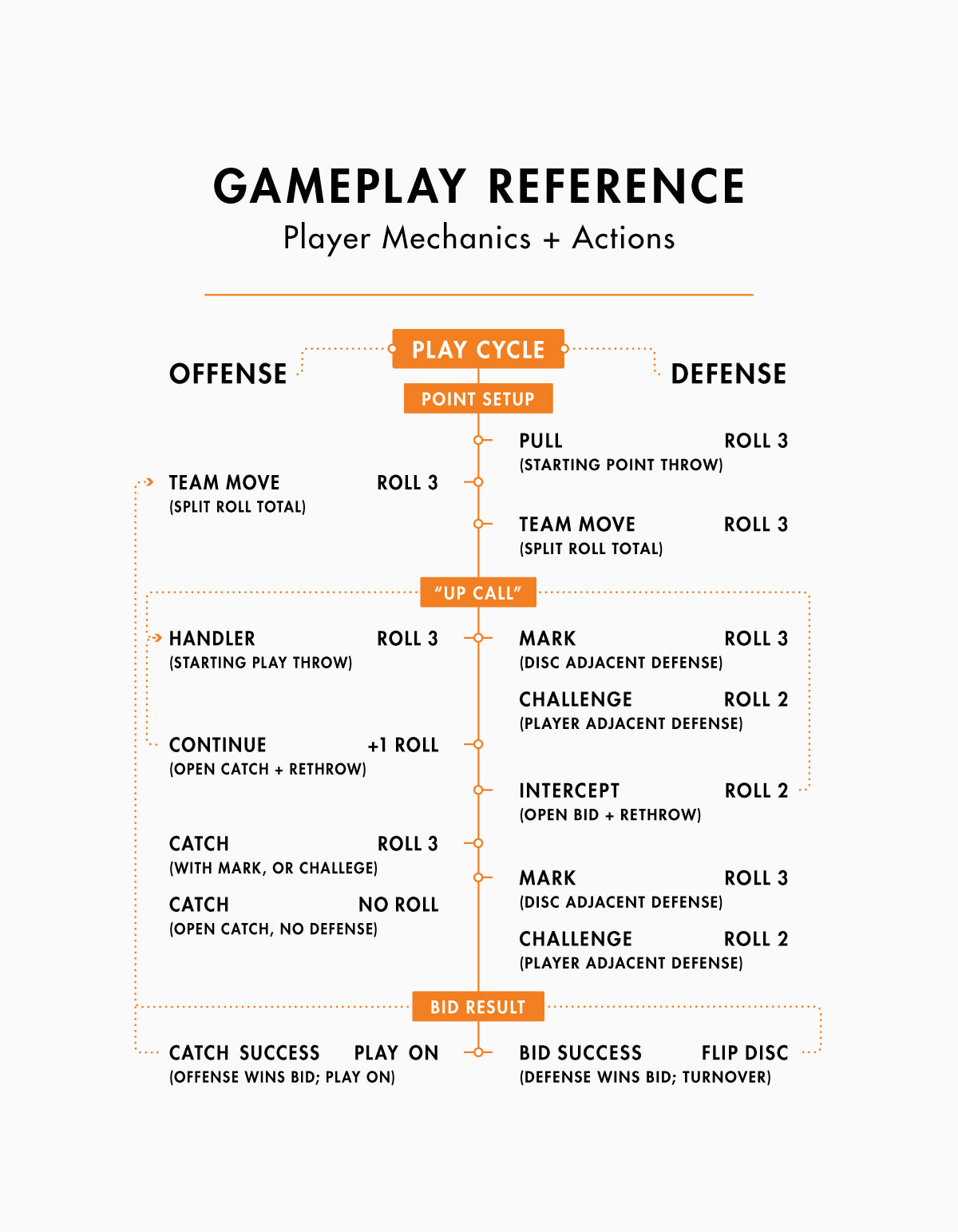
Game Flow
Huck + Monster game mechanics combine disc movement, player position, and field setup to complete a comprehensive turn-based strategy framework. Certain steps may be completed many times, while other steps may be frequently skipped.
Game mechanics work as a linear set of actions. Starting at the top center line, each key step (indicated by a dot) is an opportunity for team players to take an action. If no defensive players are within the distance of offensive action, then the action is automatically successful, with play continuing as planned.
The offensive team acts first to Throw, Continue, or Catch. If positioned correctly, defensive players then roll dice to "bid" against offensive actions.
Defensive players must roll a higher dice count total than the offensive dice count total to win the bid. The player with the highest dice count total then takes possession of the game disc, becoming the new Handler on the next Up Call.
Download Field ManualThe VISUAL GAME GUIDE
Same rules, different medium. For those Coaches who prefer visual instructions with supporting text, or would prefer to view the game play by action type, refer to our comprehensive Visual Gameplay Guidelines. Note: Rulesets may vary slightly between game guideline versions.
Table-to-Field-to-Table Gear
6 colors available
6 colors available
3 colors available
5 colors available
4 colors available
6 colors available
5 colors available
5 colors available
5 colors available

